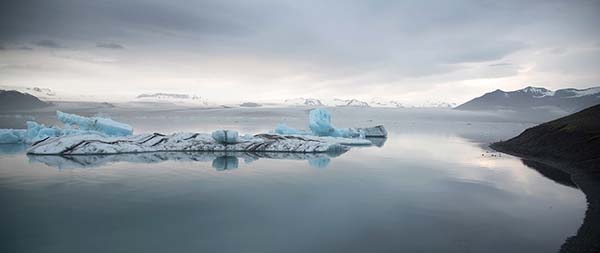
Hringvegurinn
Reykjavík to Skagafjörður Route Overview
Sights in the Skagafjörður Area
Sleeping in the Skagafjörður Area
Skagafjörður to Akureyri Route Overview
Akureyri to Mývatn Route Overview
Sleeping and Eating in Húsavík
Mývatn to Eastfjords Route Overview
Sleeping and Eating in Egilsstaðir
Eastfjords to the Southeast Route Overview
Southeast to South Coast Route Overview
Southeast Iceland Towns and Sights
Vík to Reykjavík Route Overview
Circling the Ring Road is the ultimate Icelandic road trip. You will see the country in all its moods: the deep valleys and fjordside hamlets of the north, the not-quite-bustling second city of Akureyri, the volcanic landscape around Mývatn, the desolate Eastfjords, the glacial landscape of the southeast, and the gentle, green South Coast. Be prepared for long days behind the wheel, but they’ll deliver a marvelous payoff: all of Iceland’s scenic highlights, in one big loop.
In this chapter, I outline the best five- to seven-day self-guided drive around the Ring, with plenty of suggestions for those with more time. Note that two of the day trips described earlier in this book (South Coast and West Iceland) are basically part of the Ring Road, and two others (Golden Circle and Westman Islands) can easily be spliced into your Ring Road journey.
In theory, you could do the entire Ring and all the day trips in this book, and never set foot in Reykjavík: From the airport, you could drive a couple of hours to one of the day-trip zones, spend a night there, and then continue along the Ring (for example, land at Keflavík Airport, head straight to Borgarfjörður in West Iceland, and overnight there). However, most visitors stay in the Reykjavík area for a day or two before commencing the Ring.
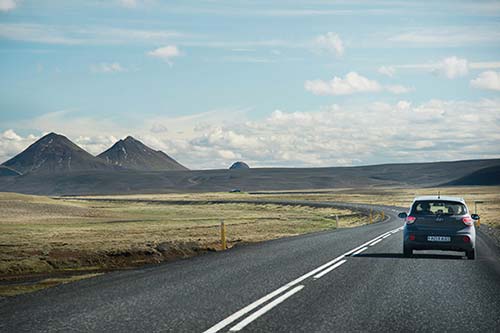

A week spent traveling Iceland’s Ring Road is an epic journey unlike any other. Let’s go!
Driving the Ring Road is a complex road trip that deserves serious planning. Use the day plans that follow as a guide as you customize your journey to match your interests, energy, and time. It’s possible to do the loop in as few as five days (and four nights)—but that requires very long driving days. If you can, aim for seven leisurely days, even if they come at the expense of something else in Iceland.
In the itinerary below, I’ve laid out a basic plan that takes you in five days—the absolute minimum—to the best-known sights, along with suggestions on where to overnight. With seven days or more, you can enjoy a saner pace, explore lesser-known destinations, avoid one-night stands, and really savor the trip. Be sure to read the Ring Road tips sprinkled throughout this chapter as you make your plans.
Note that this plan, and the closing times I list, are for summer (mid-May to mid-Sept); hours can be significantly shorter outside those months.
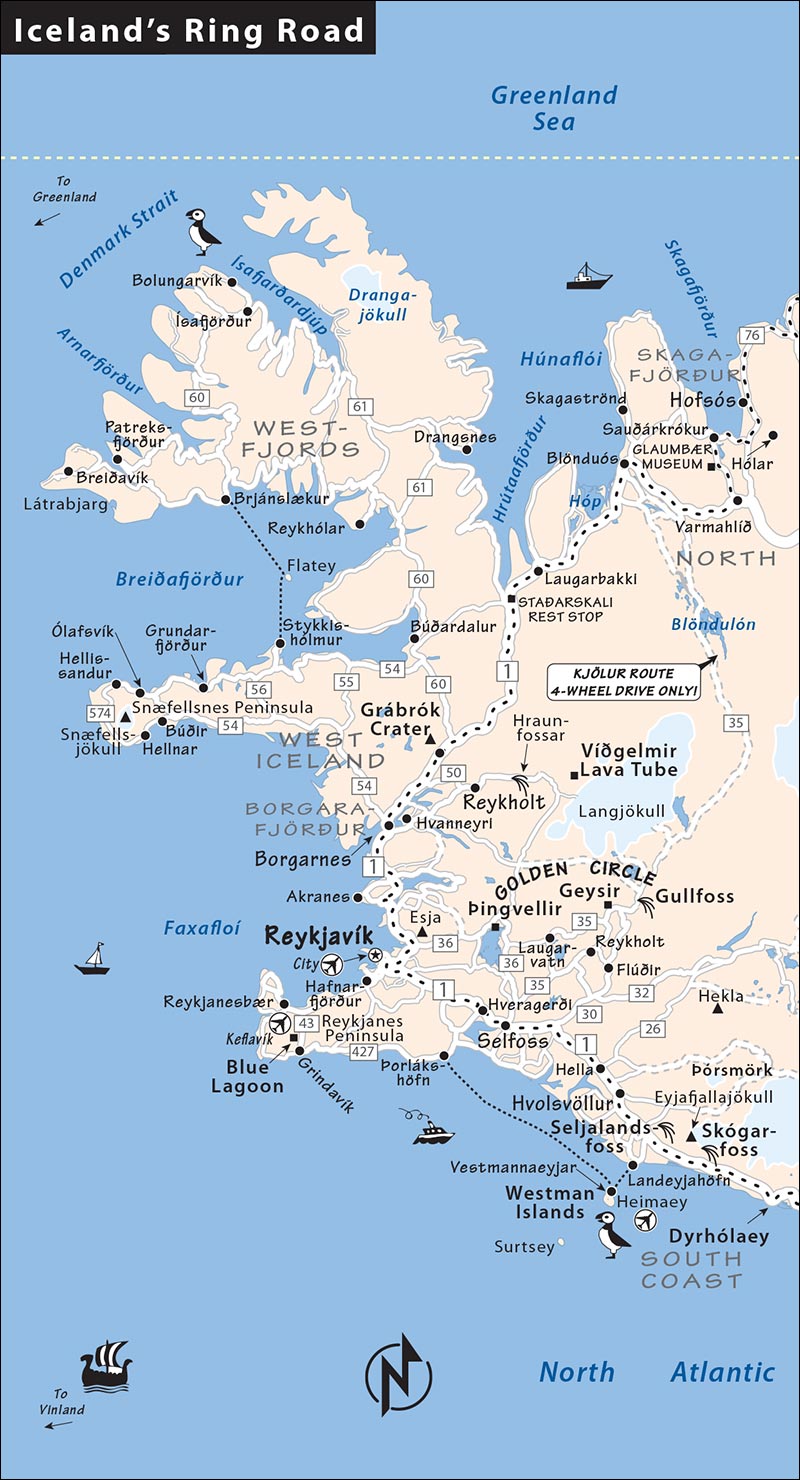

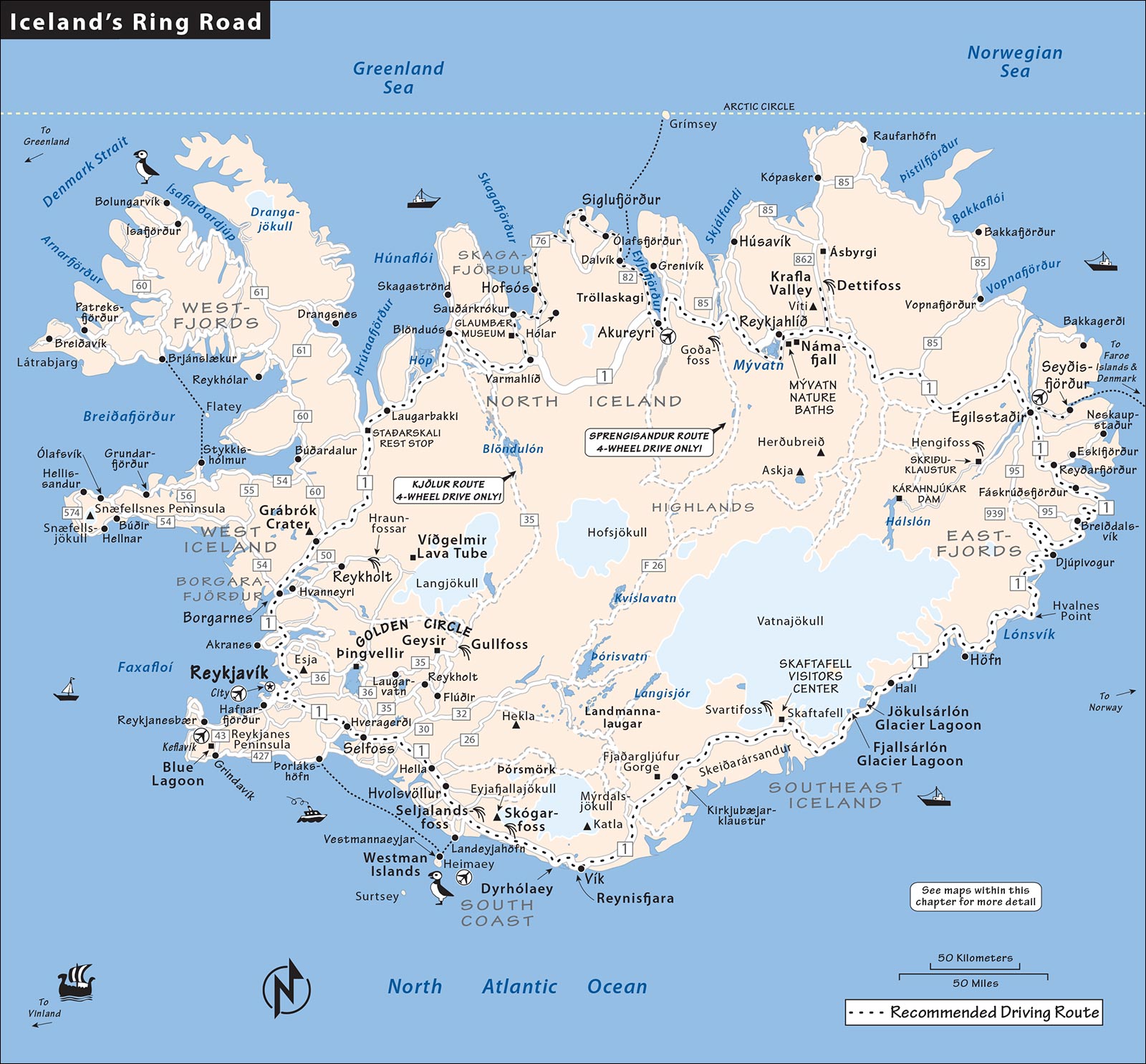
| 9:00 | Leave Reykjavík, heading for Borgarnes (1 hour) on highway 1 |
| 10:00 | Tour the Borgarnes Settlement Centre |
| 11:15 | Head to Grábrók crater (30 minutes) and hike to the top; have a picnic lunch there or stop at the Hreðavatnsskáli roadside café |
| 13:30 | Continue north to Glaumbær (2.5 hours) |
| 16:00 | Visit the Glaumbær open-air museum (closes at 18:00) |
| Evening | Eat dinner in nearby Sauðárkrókur or in Hofsós (40 minutes from Glaumbær), and end your day with a soak at the Hofsós infinity pool (closes at 21:00) |
| Sleep | In the Skagafjörður countryside |
Extra Overnight: Adding an overnight in the Borgarnes area lets you explore the sights in the West Iceland chapter (especially the area around Reykholt), and gives you a head start on the Skagafjörður and Tröllaskagi area.
You could make a beeline to Akureyri if you’re in a rush (on highway 1); but it’s worth the extra time to loop around the Tröllaskagi Peninsula and stop off in Siglufjörður.
| 8:30-9:00 | Leave Skagafjörður area and drive to Siglufjörður, at the tip of the Tröllaskagi Peninsula (1-1.5 hours depending on where you sleep) |
| 10:00 | Tour Siglufjörður’s Herring Era Museum |
| 11:30 | Enjoy the scenic drive to Akureyri (1 hour) |
| 12:30 | Have lunch in Akureyri (or in Dalvík on the way) and take a quick stroll downtown |
| 14:30 | Drive to Goðafoss (45 minutes) and view its grand waterfall, then press on to Mývatn lake (30 minutes) |
| 16:30 | Arrive in the Mývatn area, where you can sightsee around the southern end of the lake, take a restorative soak in the Mývatn Nature Baths (open until 24:00), and sleep like a log (oh, and have dinner) |
| Sleep | Mývatn area or in Húsavík |
Extra Overnight: If I were to add a night anywhere on this itinerary, it’d be in the Mývatn area. It’s strategically situated about a third of the way through the Ring; extra time here helps you fit in more of the fascinating volcanic and geothermal sights around Mývatn, and possibly even a visit to Húsavík (with a good whale museum) or a whale-watching trip from either Akureyri or Húsavík.
Akureyri, between Skagafjörður and Mývatn, is another candidate for an extra overnight. This buys you more time for the Tröllaskagi area (including the Hofsós Emigration Center) and for Akureyri itself (great municipal swimming pool and a wide choice of restaurants).
| Morning | See any Mývatn sights you missed yesterday, including the baths and the geothermal sights just east of the mountains (or consider driving 45 minutes each way to visit the charming port town of Húsavík and its whale museum); whatever you do, eat lunch before heading out, as there’s virtually nowhere to eat between Mývatn and the Eastfjords (your next destination) |
| 12:30 | Begin your drive east to Dettifoss (about an hour), and explore that spectacular waterfall |
| 14:30 | Continue toward the Eastfjords, stopping in Egilsstaðir (2 hours) if you need to stock up on food or gas; then drive along one of Iceland’s most scenic routes (45 minutes—including photo stops—over a breathtaking pass) to the appealing town of Seyðisfjörður |
| 17:30 | Arrive in Seyðisfjörður, enjoy dinner, and rest up for tomorrow’s long Eastfjords drive |
| Sleep | In Seyðisfjörður (or Egilsstaðir, which saves some driving, but costs you spectacular scenery and a charming town) |
This is easily the hardest day of driving on this itinerary. Don’t underestimate how long it takes to curve along all those beautiful fjords. Keep in mind that the most interesting sights are concentrated at the end of the day—you’ll want enough time for them. Overnight options here span a two-hour stretch of road; the farther you go tonight, the less you’ll have to drive tomorrow.
Extra Overnight: Spending a second night in Southeast Iceland can help break up two long driving days. This is particularly tempting if you’re interested in glacier activities or hiking at Skaftafell. But if you’re not doing those things, you may prefer to overnight on the South Coast instead.
Before leaving—and if you’re staying nearby—consider an easy nature hike at Skaftafell (or get up an hour earlier to hike all the way up to Svartifoss waterfall). Or, if you’ve slept near the glacier lagoons, do a cruise first thing this morning, before heading west.
| Morning | Drive west to the town of Vík, on the South Coast, aiming to get there by lunchtime (about 3.5 hours from Höfn, 2.5 hours from Jökulsárlón glacier lagoon, or 2 hours from Skaftafell, including a few brief photo stops) |
| 13:00 | Lunch in or near Vík, then go 10 minutes farther to view the black sand beach at Reynisfjara |
| 14:30 | Drive to Seljalandsfoss (1 hour) and enjoy the waterfall |
| 16:00 | Continue to Hvolsvöllur (20 minutes) and visit the Lava Centre (closes at 19:00) |
| Evening | Drive to Reykjavík (1.5 hours), having dinner en route or in the city (late) |
| Sleep | Collapse in Reykjavík. You did it! |
Extra Overnight: Adding an overnight on the South Coast allows more time on the morning of Day 5 for glacier lagoon cruises and Skaftafell hikes, and lets you spread the South Coast sights over two days, breaking up the long drive back to Reykjavík. Other options include a Westman Islands side-trip (see Westman Islands chapter) or a Golden Circle loop (see Golden Circle chapter) on your way back to Reykjavík.
If you’re adding time, and don’t mind a series of one-night stays, I’d prioritize this way:
With a sixth day, add a second night in the Mývatn area.
With a seventh day, add a night on the South Coast.
With an eighth day, add an overnight in Akureyri.
With a ninth day, add an overnight in the Borgarnes area.
With even more time, spend a second night in one (or more) of these areas, listed roughly in order of preference: Southeast Iceland; Seyðisfjörður, on the Eastfjords; or the charming North Iceland towns of Húsavík and Siglufjörður.
Here are some important considerations as you plan your itinerary. For an overview on driving in Iceland—including common road hazards and a map with driving times, see the “Driving” section of the Practicalities chapter.
Time to Allow: The entire 800-mile circuit requires a minimum of about 20 hours of driving time—but that doesn’t account for the many places along the way that sit on short spokes off the Ring. You may find yourself driving an extra hour or two to reach some of the top sights (such as the best towns—Siglufjörður and Húsavík in the north, and Seyðisfjörður in the Eastfjords—or the most impressive waterfall, Dettifoss). To get a sense of the pace you’ll need to keep, figure on about 30 total hours of driving, and divide by the number of days you’ve allotted (with five days, you’ll average six hours a day behind the wheel).
Remember that you’ll be stopping frequently en route for sightseeing, and sometimes briefly hiking to reach a point of interest. Don’t overdo it: The driving can be tedious in places, and challenging in others.
When to Go (and When Not to Go): The best time to drive the Ring Road is between mid-May and mid-September. Don’t drive the full Ring anytime from November to March. April and October are chancy; if you’re lucky, you’ll dance between the snowstorms, but just as likely, an icy or closed mountain pass will block your progress and mess up your itinerary (in these months, prudent drivers should skip the Ring and stick within two or three hours of Reykjavík). Late September and early May along the Ring are fairly reliable, but you still could encounter slippery roads or a freak snowstorm at higher elevations. Regardless of when you travel, keep a close eye on the road conditions map at Road.is.
Two- or Four-Wheel Drive? In summer, rent a two-wheel drive car; you won’t need four-wheel drive if you’re circling the island in a week. Nearly the entire Ring is paved (except for some short stretches, mostly in the east), and the most rewarding detours are either paved or on gravel roads that are passable in a two-wheel drive. Although a four-wheel drive gives you a little more comfort and speed on unpaved roads, it’s generally not worth the extra cost.
Clockwise or Counterclockwise? The Ring works well in either direction. I lean toward clockwise, which is how I’ve organized this chapter. The northwest quarter of the Ring is the least spectacular, so doing the trip clockwise lets you build to ever-greater highlights.
Sleeping Along the Ring: The trickiest part of your Ring itinerary is figuring out where to stay overnight. If plotting out an exact itinerary and booking accommodations in advance, you’ll generally end up with a string of one-nighters. Be flexible on location; for example, when researching Mývatn accommodations, you might find better prices and availability in nearby Húsavík. Book well ahead—as far you can—as accommodations along the Ring fill up weeks (or even months) in advance during the summer. With Iceland’s geography and dispersed settlement in mind, I’ve highlighted general areas that work well for an overnight and recommended a few reliable establishments that I’ve checked out and like. Still, it’s smart to look around on Airbnb or Booking.com, and consider well-rated alternatives.
Another option is to camp, either with a campervan or tent. With a campervan, every parking lot becomes a potential hotel; with a tent, you just need a campsite to pitch it in, and Icelandic campsites practically never fill up. Both options leave you free to change your itinerary on the fly (for more on campervans and camping, see here).
WCs: Driving through the countryside, often your best (or only) WC option will be at a parking lot or café for a major sight. Some may be free, but most charge a fee (typically 100-200 ISK); some accept credit cards, but others require cash. Have a small amount of currency on hand for these situations. WCs at gas stations and at a café or restaurant where you are buying food are typically free.
Not Enough Time to Drive? If you don’t want to drive the entire Ring Road but want to get a quick look at the north, a good plan is to fly from Reykjavík to Akureyri (frequent Air Iceland Connect flights take less than an hour) and home-base there for a few days, day-tripping by rental car, public bus, or excursion to places like Siglufjörður and Mývatn (each less than 1.5 hours away). Egilsstaðir, in the Eastfjords, is also reachable by plane from Reykjavík, with rental cars available at its airport.
Ring Road Excursions: If you want to do the Ring but don’t want to drive it yourself, some boutique tour companies (including www.nicetravel.is and www.seasontours.is) offer seven-day excursions—for a very steep price.
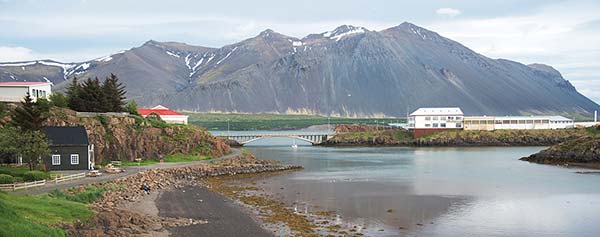
Your Ring Road journey begins with a spin through West Iceland—the region called Borgarfjörður. This area has some fine sights and can be a satisfying side-trip from Reykjavík, but those doing the entire Ring Road will find more impactful sights, charming towns, and dramatic scenery farther along. For that reason, Ring Road through-trippers should feel free to make short work of West Iceland—stopping only at its two most worthwhile sights: the Settlement Centre in the beautifully set town of Borgarnes, and the fun-to-climb crater called Grábrók.
Planning Tips: If you’re doing the Ring Road at a more leisurely pace (with more than a week), this area can be a convenient first stop, especially if you’re setting out on the Ring right after your Iceland arrival. It’s a fairly straightforward two-hour drive from the airport to the charming small town of Borgarnes, a fine place for your first night in Iceland before carrying on with the rest of the Ring.
For more on this region—including a map, specific driving instructions from Reykjavík, and a complete rundown of the area’s sights—see the West Iceland chapter. This leg takes about 4.5 hours without stopping.
• Drive north from Reykjavík along highway 1, following signs for Borgarnes, Akureyri, and 1n. About one hour from Reykjavík, a bridge crosses into...
This fine town of 2,000 people perches on a little peninsula facing sheer scree cliffs. Borgarnes (BOHR-gahr-NESS) has some historical ties to the early Icelandic sagas (especially the colorful warrior-poet Egill); you can learn more about him and the earliest days of Iceland’s habitation in the Settlement Centre, which is well worth an hour (described on here).
Additional sights cluster about a half-hour east of Borgarnes, in the area near Reykholt (thermal springs and waterfalls, family-friendly goat farm, busy thermal-pool complex, lava cave, important early Icelandic Christian sights—all described in the West Iceland chapter). But for those blitzing the Ring, all are skippable.
• To continue directly along the Ring Road, head north from Borgarnes on highway 1. After about 30 minutes, along the road on your left, you can’t miss the towering crater called Grábrók. The parking lot is also on the left, immediately after the crater.
Climbing to the top of Grábrók takes about 30-45 minutes round-trip and offers grand views over the region (for details on the crater and the lunch spots listed next, see here).
Lunch Options: Consider getting lunch near Grábrók before heading north over the mountains. Options include the $ Hreðavatnsskáli roadhouse café, and the more upscale $$$ Hraunsnef. Otherwise, two basic, roadside restaurants lie between here and Skagafjörður (described in the North Iceland section, later).
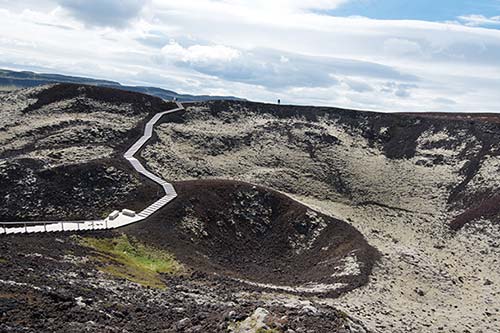
• After visiting the crater, get back on highway 1 north.
As you approach the pass over Holtavörðuheiði (“Hill-Cairn Heath”), the farms thin out and the road climbs, finally cresting the pass at almost 1,400 feet.
Coming back down, you’ll see the small Hrútafjörður (“Ram Fjord”) spread out before you. Just before the road meets the fjord, you’ll hit $ Staðarskáli, a big rest-stop complex (free WC, burgers, Wi-Fi, long hours daily, tel. 440-1336, www.n1.is).
Another hour of driving on highway 1 across a relatively flat, dull landscape brings you to Blönduós, a small town along the Blanda river known to most Icelanders for its speed traps. There are a few restaurants here, including $$ B&S (daily 11:00-21:00, next to the big N1 gas station at the top of town, tel. 453-5060, www.pot.is).
As you make the trip over the mountain range from Blönduós to the Skagafjörður area, you’ll be crossing into North Iceland (covered in the next section). For this leg of the trip, you have a couple of route options.
Highway 744 to Sauðárkrókur or Hofsós (40 minutes/1 hour): If you’re in a hurry to reach either of these towns, highway 744 is faster, lower in altitude, recently upgraded, and nicely scenic.
Highway 1 Bypass to Varmahlíð (40 minutes): This equally scenic road crosses the Vatnsskarð pass to the hamlet of Varmahlíð (VAR-mah-HLEETHE, “Warm Slope,” pop. 140), with a gas station, hotel, school, swimming pool, and shop. Just before town is a turnoff to Víðimýrarkirkja, an 1834 sod-wrapped timber-frame church (small entry fee, open daily in summer).
From Varmahlíð, you have several options. Turning left on highway 75 takes you to the area’s most interesting sight, Glaumbær Museum (less than 10 minutes) and the town of Sauðárkrókur (20 minutes); the road eventually connects with highway 76, which runs through Hofsós (45 minutes from Varmahlíð) and the Tröllaskagi Peninsula. All of these are described in the next section.
Continuing along highway 1 from Varmahlíð leads to the bigger city of Akureyri (1 hour). Note that if you stay on highway 1 straight through, you’ll bypass the Skagafjörður fjord altogether and miss its most interesting sight, the Glaumbær Museum. Unless you’re in a huge rush, be sure to turn off and enjoy the Skagafjörður area.
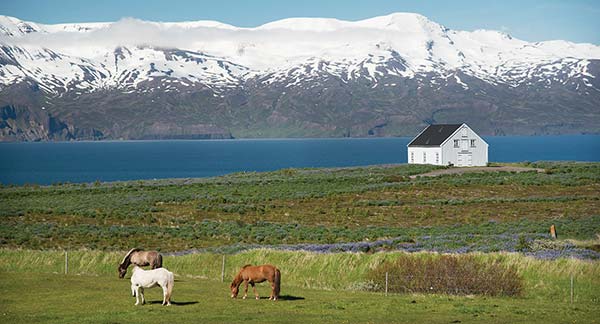
North Iceland is a delight, with beautiful fjords, the scenic Tröllaskagi Peninsula, Iceland’s pleasant second city of Akureyri, and the country’s most fascinating volcanic area at Mývatn. If this area were a bit closer to Reykjavík, it would be swamped with tourists. But it isn’t…so it’s not.
Planning Tips: Those without enough time to do the entire Ring could consider spending just a few nights in this area. But by car it’s a long, six-plus hours one-way. A more efficient plan is to fly from Reykjavík to Akureyri, rent a car there (or do excursions) for two or three days of side-tripping, then drive or fly back to the capital.
Skagafjörður (SKAH-gah-FYUR-thur, “Peninsula Fjord”) is the name of this broad fjord and of the valley at its head. The Skagafjörður area has a picturesque seaside setting, a few humble towns (Hofsós is the most interesting), and several intriguing islands just offshore.
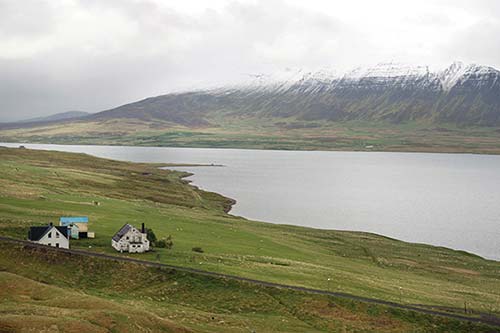
There are enough attractions here to keep you busy for several hours—including one of Iceland’s most interesting folk museums, at Glaumbær; the evocative Icelandic Emigration Center, in Hofsós; and a tranquil valley that was an important site in the early days of Icelandic Christianity, at Hólar. The area also has several horseback riding options, and a rare Icelandic river suitable for rafting.
Planning Tips: The Skagafjörður area is sparsely populated—and not well-developed for tourism. Compared to some of the country’s more mainstream destinations, you may need to lower your standards somewhat. If you make good time getting to this area, a possible late-afternoon plan is to close down the Icelandic Emigration Center in Hofsós (open until 18:00 in summer); take a dip in that town’s relaxing, thermally fed infinity pool overlooking the fjord (open until 21:00 in summer); then grab dinner on your way back to your accommodations.
These sights are listed in the order you’ll approach them on highways 75 and 76 from the main Ring Road. For directions, see “From Blönduós to the Skagafjörður Area,” earlier.
Inhabited until 1947 and a museum since 1952, this classic turf farm (pronounced GLOYM-bire) shows how Icelanders lived for centuries, with limited access to timber for building and fuel. It’s larger and better preserved than other similar farm-museums in Iceland, and offers perhaps the country’s most informative and intimate look at traditional Icelandic lifestyles. It rates ▲▲▲ for those interested in Icelandic history.
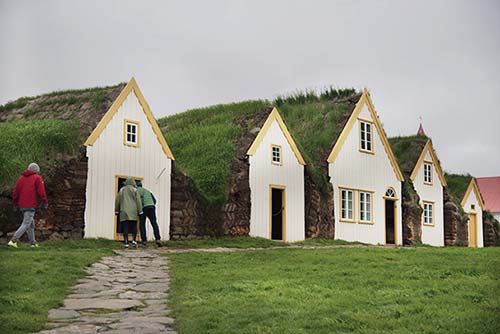
Cost and Hours: Free to wander the grounds, but well worth paying 1,600 ISK to enter the farmhouse complex; late May-late Sept daily 9:00-18:00; April-late May and late Sept-late Oct Mon-Fri 10:00-16:00, closed Sat-Sun; late Oct-March by appointment only; on highway 75 (less than 10 minutes north of highway 1 at Varmahlið), tel. 453-6173, www.glaumbaer.is.
Eating: The sod houses sit between a modern church and two late-19th-century timber houses that were moved here in recent decades. In one of them, the cozy $ Áskaffi café serves soup, sandwiches, cakes, and a tasting plate of traditional Icelandic smoked and preserved foods (closed late Sept-April; tel. 453-8855, www.askaffi.is).
Visiting the Museum: The walls of the farm are made of sod and driftwood, with timber fronts and stone foundations. Study the alternating diagonal pattern used to pile up the layers of sod. The tops of the houses are covered with grass—the original roof garden. While the facades give the impression of separate buildings, inside the rooms are all connected.
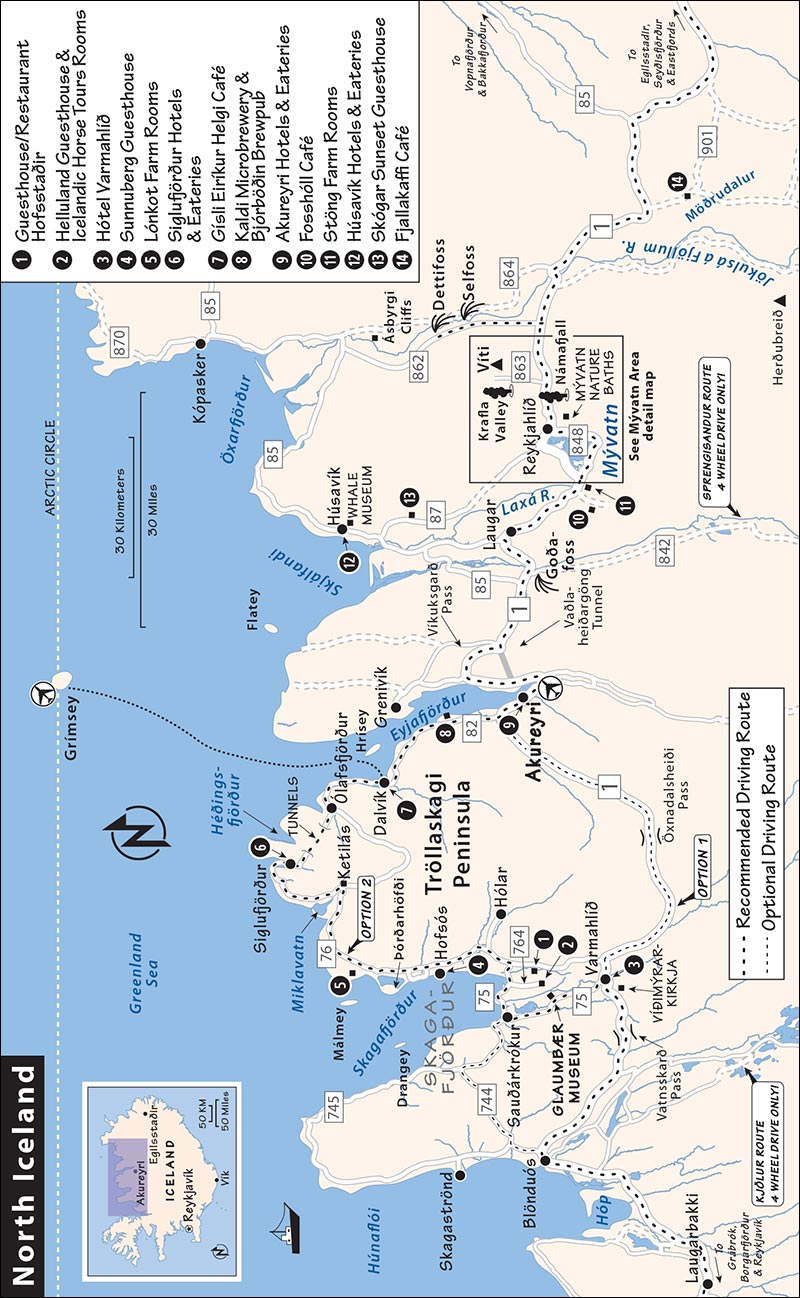
Each room is explained by an English leaflet. At the front of the house is the nicest (and least troglodyte-style) room, reserved for guests. From there, a long, claustrophobic sod hallway connects the kitchen (with a fire fed by peat or dried sheep dung) with various pantries and storage rooms, where you’ll see big barrels of animal innards and skyr—now a trendy yogurt-like snack, but back then a well-preserved staple.
At the back of the complex, you’ll pop into the fascinating baðstofa—the communal living and sleeping room, lined with dorm-like beds where workers slept, two to a bed. The women—who did delicate spinning and knitting work—got the bunks with better light, near the windows. The smaller, more genteel room on the left was for the farmer and his wife; the one on the right was for children (notice the loft bed, with a step for easier access).
Here you can understand why the Scandinavian words for “bed” come from the same word as the English “room.” Each bed’s opening is blocked off by a wooden panel (called a rúmfjöl) engraved with prayers. Also look for the little, lidded pot above each bed; every person had their own personal pot (askur) from which they ate every meal. Imagine spending a long, dark, cold winter in here, huddled around the dim light of a candle. People stored personal items under their pillows—the only place that was strictly off-limits to everyone else.

Back outside, you can peek into a few more rooms that held farming tools. The complex even had its own little blacksmith’s workshop.
The provincial center of Sauðárkrókur (SOY-thour-kroh-kur, “Sheep River Bend,” pop. 2,500) enjoys a spectacular fjordside setting about 15 minutes north of Glaumbær, but the town itself is dreary. It’s convenient for gassing up, grabbing a meal, or setting up bird-watching or sea-cruise excursions—but otherwise, I’d give it a miss.
Eating in Sauðárkrókur: Most of the limited options line up within a block or so along the main street, Aðalgata (a couple of blocks inland from the main highway). $$ KK Restaurant (a.k.a. Kaffi Krókur) has a big, bright interior and a typical burgers-and-pasta menu (daily 12:00-22:00, Aðalgata 16, tel. 453-6454, www.kkrestaurant.is). $$ Hard Wok Café serves an acceptable approximation of Asian and Mexican dishes, plus pizza, in a pleasant setting (June-Aug daily 11:30-21:30, off-season closed 14:00-18:00 Mon-Fri, Aðalgata 8). $ Sauðárkróksbakarí is a popular main-street bakery with pastries and basic sandwiches, and inviting indoor seating (Mon-Fri 7:00-18:00, Sat-Sun 9:00-16:00, Aðalgata 5, www.saudarkroksbakari.net). There’s also a supermarket in town.
Hólar (HOE-lar, “Hills”), a pretty settlement at the upper end of a small valley, is a scenic detour if you have an hour to spare and an interest in Iceland’s history (from highway 76, turn off on highway 767 for about 15 minutes/8 miles).
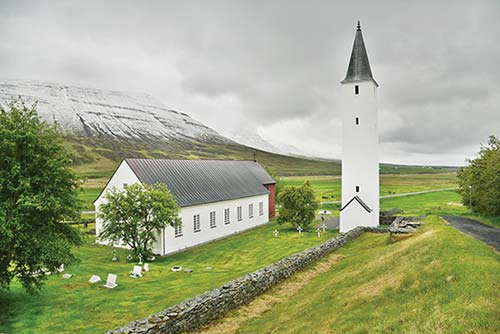
The center of Iceland’s northern bishopric up until 1800, Hólar had one of the country’s first printing presses and is now home to a small college (Hólaskóli), a historic church, a trio of little turf-roofed houses (not open to the public), and an exhibit on Icelandic horses (only in Icelandic; open June-Aug Tue-Sun).
Hólar was home to a colorful and important bishop, Guðmundur Arason (1161-1237). An orphaned, disabled ascetic, Guðmundur devoted himself to the poor and needy. After he became bishop of Hólar, Guðmundur gathered a motley crew of desperately needy people, whom he sustained with church wealth. He became known as “Guðmundur the Good.” However, his unusual ways—and his assertion of the judicial powers of the church—drew attention from the chieftains. The two factions came to blows, and Guðmundur was at various times imprisoned or sent into exile.
About 300 years later, another Hólar bishop—Jón Arason—was the main holdout of the Protestant Reformation. Jón was eventually executed at the headquarters of the other old Icelandic bishopric, Skálholt (on the Golden Circle).
On the east side of the fjord—about 40 minutes from Glaumbær, or 30 minutes from Sauðárkrókur—the village of Hofsós (HOFF-sose, “Temple Estuary,” pop. 200) merits a stop, especially for anyone of Icelandic descent. A one-time summer trading center, it got its start in the 18th century, but never developed into a large town. Today it’s a functional village with a fine location perched on a bluff overlooking the fjord. (The late Icelandic-Minnesotan author Bill Holm, who some will remember from his appearances on A Prairie Home Companion, spent summers in Hofsós and wrote about the town in The Windows of Brimnes.)
The core of the village (with the swimming pool and recommended guesthouse) is separated from its old port by a big river. To reach the port area—with the main buildings of the Emigration Center—you’ll either have to loop all the way around on the road, or park by the Sólvík restaurant and take the footbridge.
Icelandic Emigration Center (Vesturfarasetrið): This is the main sight in town—worth ▲, or ▲▲▲ if you have Icelandic ancestry. It fills three historic buildings on the old port. The low-tech but thorough exhibits tell the story of the 20,000-some Icelanders who emigrated to the Americas from 1870 to 1914—a time when a series of volcanic eruptions, lower temperatures, and a general lack of prospects conspired to make life very difficult, particularly in the northern parts of the island. In 1860, more Icelanders died than were born. Those who fled went mainly to Canada, where part of Manitoba became known as “New Iceland”; others wound up in the Dakotas, and a handful went to Brazil.
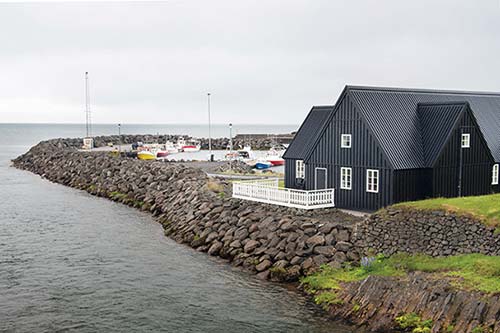
To see the museum, first tour the overview exhibit in the light green house (including a peek into a typical fishing shack—burrabúð, or “dry house,” and in the basement, a glimpse at life at sea and what the émigrés found when they reached the New World). In the big, black house, a touching exhibit of photographs (made in 1890) lets you look into the brave faces of an Icelandic immigrant community in Manitoba. And across the footbridge, you’ll learn about an Icelandic settlement in North Dakota. Visitors can also use the genealogy library (1,700 ISK, June-Aug daily 11:00-18:00, Sept-May by appointment, tel. 453-7935, www.hofsos.is).
Thermal Swimming Pool: Hofsós sports a fine, large municipal pool, which opened in 2010 as a gift to the village by two very wealthy Icelandic businesswomen. Entirely outdoors, the complex has both a big, warm infinity pool (with unobstructed views over the icy waters of the fjord) and a smaller hot pool. If you only have time for one thermal pool on your Ring drive, this is a good choice—small, user-friendly, scenic, reasonably priced, and in an area with few other evening diversions (900 ISK, generally daily in summer 9:00-21:00, tel. 455-6070, www.facebook.com/sundlauginhofsosi).
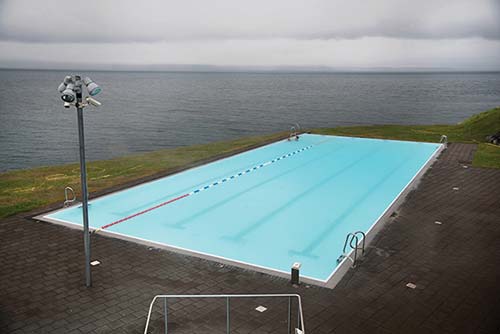
Eating in Hofsós: The only real eating option is the casual $ Sólvík restaurant, filling a cozy house down near the footbridge, with a short but appealing menu of fish, lamb, and burgers (daily 10:00-21:00, mobile 961-3463).
Skagafjörður is a good place to spend the night. While accommodations in the fjord’s main town, Sauðárkrókur, are gloomy, several fine countryside options are more appealing. Another option is to carry on about 1.5 hours farther to sleep in Siglufjörður, near the tip of the Tröllaskagi Peninsula (with some excellent accommodations—see recommendations later in this chapter).
Overlooking the Skagafjörður Valley: $$$ Guesthouse Hofsstaðir is a cozy oasis perched on a ridge, with cut-glass peaks in one direction and the broad estuary of the Skagafjörður valley in the other. Well-run by Rósa María, they have 20 rooms (all with private bath and views) and a relaxing upscale-log-cabin vibe (tel. 453-7300, www.hofsstadir.is, info@hofsstadir.is). Their good $$$ restaurant, open to all, has an appealing menu and sells homemade syrups and jams (daily 18:00-22:00, reserve ahead off-season). Coming from Sauðárkrókur on highway 75, turn right at the T-intersection with highway 76 (signed for Reykjavík and Akureyri); the guesthouse is a few minutes south.
$ Helluland Guesthouse has five simple but tidy, modern, and nicely appointed rooms, all with shared bath, plus a bright and cheery breakfast room and a mod lounge. High on a ridge overlooking the valley, it’s a winner (tel. 853-3220, www.helluland.is, info@helluland.is). If you’re in a pinch, their neighbor, $ Icelandic Horse Tours, has three even simpler rooms (tel. 847-8577, www.icelandhorsetours.com, info@icelandhorsetours.com). To reach either, head east from Sauðárkrókur on highway 75. After crossing the bridge, immediately turn right on highway 764 (marked Hegranes); the guesthouses are on the left after two miles (about 5 minutes on the unpaved road).
Practical Hotel in Varmahlíð: At the junction of highway 1 and highway 75—a short drive south of Glaumbær and the fjord—sits $$$ Hótel Varmahlíð. It’s overpriced but convenient and relatively large (with 19 spacious rooms)—so it may have beds when others are full. It also works well if you’re skipping the Skagafjörður sights, and just need a place to sleep before continuing east on highway 1 (tel. 453-8170, www.hotelvarmahlid.is, info@hotelvarmahlid.is).
In Hofsós: The simple $ Sunnuberg Guesthouse fills a modern house right in the heart of the village (facing the little grocery/gas station). Its five practical rooms are nothing fancy—no frills and no breakfast, though you can use the kitchen to make coffee—but the rooms all have private bathrooms, and the price is reasonable (Suðurbraut 8, tel. 893-0220, www.sunnuberg.is, gisting@hofsos.is).
Just North of Hofsós: $$ Lónkot, a remote waterfront farm with six basic rooms about 15 minutes north of Hofsós along the coast, is handy for those continuing around the tip of the Tröllaskagi Peninsula (cheaper rooms with shared bath, restaurant, Lónkot 76, tel. 453-7432, www.lonkot.is, lonkot@lonkot.is).
When you’re ready to proceed from the Skagafjörður area to Akureyri, you have two choices: Drive inland on highway 1, over a mountain pass, to Akureyri; or—my preference—invest a little extra time to take one of Iceland’s classic scenic drives: north around the tip of Tröllaskagi Peninsula (“Troll Peninsula”).
Option 1, Tröllaskagi (about 115 miles, 2.5 hours): This route stays at lower altitudes as it hugs the northern coast through the towns of Hofsós, Siglufjörður (an appealing small town), Ólafsfjörður, and Dalvík, before heading south along Eyjafjörður to Akureyri. The road is very scenic the entire way around and well worth the extra time. (For a detailed description of the Tröllaskagi route, see below.)
Option 2, Straight Shot on Highway 1 (about 60 miles, 1 hour): From Varmahlíð, highway 1 heads southeast over the Öxnadalsheiði pass (1,800 feet). The road is good, fast, scenic, and fun to drive, but can easily get snow in April and October (or even May and September). Near Akureyri, it broadens out into a fine green valley under jagged mountain peaks.
Which Route to Take?: The decision depends largely on how much time you can spare. The faster inland route buys more time in Akureyri, and—if continuing onward the same day—gets you into the Mývatn area earlier (you’ll be glad to have more time for its many wonderful sights). The attractive coastal route runs along the sea (and Siglufjörður will tempt you to stop), but you’ll sacrifice some time in Akureyri and Mývatn. If you have a night in Akureyri, or a second night near Mývatn, the Tröllaskagi detour is easier to justify.
The choice also depends on your departure point in Skagafjörður. If you sleep as far north as Hofsós, continuing north around the coastal route is only about 30 minutes slower than backtracking to highway 1 (not counting sightseeing stops).
The mountainous Tröllaskagi (TREW-tlah-sky-ee)—“Troll Peninsula”—is flanked by two fjords, Skagafjörður and Eyjafjörður. Drivers who opt for the scenic route around the peninsula’s tip will curve high above the sea and skirt deep glacial valleys. Along the way, you’ll be tempted to stop for photographs (use the strategically placed, scenic picnic pullouts), and two of the towns—Hofsós and Siglufjörður—have good museums that merit an hour or two of your time. The drive around the peninsula—from the heart of the Skagafjörður area to Akureyri—takes about 2.5 hours.
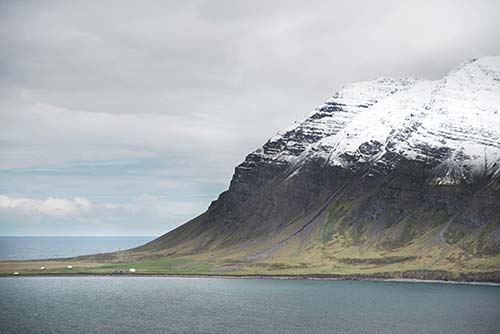
• From Varmahlíð or nearby, head north to highway 76.
About 15 miles from the base of the fjord is the tiny village of Hofsós, with its fine Icelandic Emigration Center and small but tempting thermal swimming pool, overlooking the fjord. (For more on Hofsós, see earlier in this chapter.)
Continuing north, look out to the dramatic offshore islands: In good weather, you’ll be able to see the more distant Drangey island, a popular destination for birders. If it’s socked in, you might pick out a pair of closer-in islands: the table-like Þórðarhöfði (technically a peninsula, connected to the mainland by a sandy causeway), then Málmey.
As the road curves right—heading around one of the peninsula’s fingers—it alternates abruptly between paved and unpaved stretches. Steady as you go, carrying on through desolate, spectacular scenery.
• As you approach the Miklavatn lagoon, at the junction called Ketilás (with an N1 gas station), you hit a T-intersection; turn left to stay on highway 76 (marked Siglufjörður).
Curl up along the far side of the water, with nice views back on the mountainous coastline. As you reach the topmost part of the peninsula, look out to sea and realize that the next stop is the Arctic Circle. This is the northernmost point of this drive—and perhaps the farthest north you’ll ever be in your life.
• About 45 minutes after leaving Hofsós, the road winds along high bluffs over the sea before taking you through a short tunnel that deposits you in the adorable town of Siglufjörður.
The town of Siglufjörður (SIG-loo-FYUR-thur, “Mast Fjord,” pop. 1,200) is reason enough to tour Tröllaskagi. Tucked away from the sea at the end of a short fjord, and dramatically flanked by high peaks, it has a tidy charm and a pioneer spirit. The harborfront provides a lovely stroll, and colorful homes scamper up the hillside above town. There’s a free parking lot right at the old harbor downtown, next to the landmark Sigló Hótel and a short walk from the Herring Era Museum. There are public WCs at the adjacent campground.
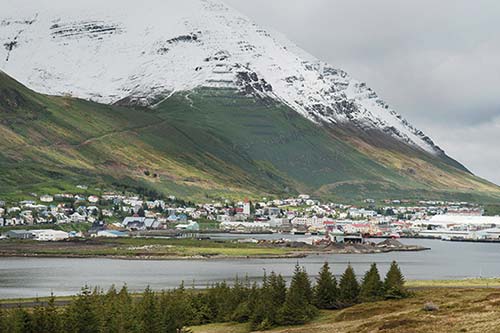
Fish is what put the town on the map. Practically no one lived here until the mid-19th century, when locals started to use the good harbor as a trading post and shark-fishing base. Later, herring took over, and the town boomed from about 1900 until mid-century, when herring stocks began to collapse.
At its peak, Siglufjörður’s harborfront was jammed with piers, bristling with boats, and fragrant with fish-processing stations; the population swelled to over 3,000. Salted herring—nutritious and well-preserved—was prized in many countries during the world wars, and for a time represented up to half of Iceland’s total export income. In fact, the wealth generated by the herring operation here helped make Iceland financially independent—and, soon after, politically independent—from Denmark. But by the late 1960s, the herring shoals had disappeared for good, and Siglufjörður’s population crashed. Today this burg is sleepy, with a little fishing and more and more tourism.
Herring Era Museum (Síldarminjasafn): One of Iceland’s most engaging, this museum (worth ▲▲) has exhibits filling three large, historic buildings, right along the main road (just past Sigló Hótel toward Akureyri). It’s well worth an hour (or more) of your time. I never knew the herring industry could be so fascinating (1,800 ISK, June-Aug daily 10:00-18:00, May and Sept 13:00-17:00, Oct-April by appointment, Snorragata 10, tel. 467-1604, www.sild.is).
Begin at the red building at the far end of the row—the Salting Station (a.k.a. “Róaldsbrakki,” from 1907). At the entrance, notice the panoramic photograph of the embankment out front—now so sleepy—lined with hundreds upon hundreds of herring-filled barrels. This Norwegian-owned factory (one of 23 salting stations in town) could crank out 30,000 barrels of salted herring in a year. On the main level, peek into the offices of a typical herring company. Don’t miss the creaky upstairs, with the living quarters for the “herring girls” who lived and worked here, 50 at a time, through the herring season. All summer long, the girls worked outdoors, rain or shine, cutting and salting herring. You’ll see rows of dorm-like beds, with clothes still hanging from hooks and music playing on the wireless. At the very top of the attic, equipment hangs from the rafters. Exiting this building, find the warehouse down below, where the salting line and storage areas were.
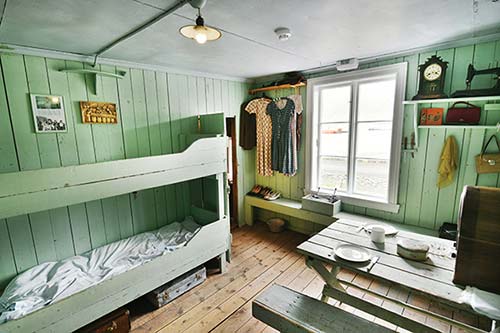
Then head to the multicolor-fronted building next door, the Fish Factory—a jumble of heavy machinery where some of the catch was processed into oil or fishmeal (for animal feed). You’ll see everything from an old hand press to motorized equipment powered by a huge diesel engine. The exhibits upstairs help tell the story.
Finally, enter the yellow Boathouse, where you can stroll through a re-creation of the jammed harbor at its peak. Step into shacks decorated with antique pulleys, lanterns, nets, buoys, and other tools. Walk around on the decks of the largest boat (the Týr), imagining this scene multiplied a hundredfold on the harbor out front.
Sleeping in Siglufjörður: One of Iceland’s most appealing high-end, fjordside hotels, $$$$ Sigló Hótel fills a picture-perfect building on the waterfront in the middle of town. Everything is done with class in its 68 harbor-view rooms and its stay-a-while atrium bar/lounge. If you’re going to splurge on an Icelandic fjord, do it here (private hot tub and sauna, Snorragata 3, tel. 461-7730, www.siglohotel.is).
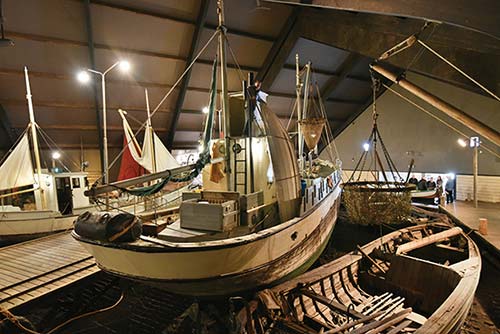
$$ Siglunes Guesthouse, a few short blocks away in a residential zone, is a homey place (well-run by proud Hálfdán) with 19 rooms above a dark, retro-feeling lounge. It’s a nice mix of antiques, modern features, and local artists’ work. About half the rooms have private bathrooms (breakfast extra, Lækjargata 10, tel. 467-1222, mobile 659-9699, www.hotelsiglunes.is).
Eating in Siglufjörður: Sigló Hótel runs several eateries in the colorful sheds around the harbor. Of these, $ Kaffi Rauðka (in the red building) serves basic but good fish, burger, and soup lunches, and has outdoor seating (daily 12:00-17:00, Fri-Sat until 22:00, tel. 461-7730, www.kaffiraudka.is). A block north is the little main square (directly under the church) and another good eatery: $ Torgið (“The Square”), a popular, casual bar/café with international cuisine (lunch and dinner served daily, likely closed for lunch off-season, tel. 467-2323, www.torgid.net). If you’re around at dinnertime, venture a block farther to the recommended $$ Siglunes guesthouse, which serves an interesting Moroccan-fusion cuisine (closed Mon).
• As you leave Siglufjörður, head south.
From Siglufjörður, you’ll drive up on a headland (scenic pullout on the left), then disappear into a long tunnel. After 2.5 miles, you’ll pop out at a virgin lake, Héðinsfjarðarvatn, a good picnic spot.
From here, you’ll immediately enter an even longer tunnel (4.5 miles), eventually surfacing above the town of Ólafsfjörður.
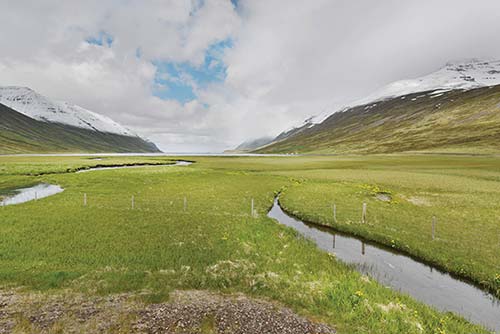
• Passing through Ólafsfjörður, the road becomes highway 82 and follows alongside the fjord.
Leaving Ólafsfjörður (picnic pullout on the left), you’ll begin to gain altitude, and go through an older one-lane tunnel with passing places. Signs explain who has to pull over (there’s even an instructional YouTube video—search “Ólafsfjarðargöng”). You’ll emerge along the shore of Eyjafjörður (“Island Fjord”)—whose name is inspired by its resident island, Hrísey, which you can’t miss ahead of you, just offshore.
• Next stop, Dalvík.
Pulling into the town of Dalvík (“Valley Bay”), you’ll drive along its busy harbor. Where the road bends right and heads inland, consider stopping at the $ Gísli Eiríkur Helgi café. This relaxed and inviting coffeehouse has great view seating upstairs; sells good coffee, cakes, and sandwiches; and puts on an excellent lunchtime soup-and-bread buffet (daily 12:00-22:00, Grundargata 1, mobile 666-3399).
• Continue south on highway 82.
Beer pilgrims might consider a short detour at Árskógssandur (“Riverwood Sands,” about 7 miles/10 minutes past Dalvík). This is home to Kaldi, Iceland’s oldest microbrewery (since 2006), which offers tours of its factory (2,000 ISK, hourly tours Mon-Fri 11:00-15:00, call ahead at other times, tel. 466-2505, www.bruggsmidjan.is). A short drive away is their brewpub, Bjórböðin, with locally produced beers, food, and even a beer spa—where you can immerse yourself in the hoppy stuff (reserve ahead for the spa, www.bjorbodin.com).
• Highway 82 dead-ends at highway 1 (the Ring Road proper), about 20 miles beyond Dalvík. From the T-intersection where highways 82 and 1 meet, it’s six more miles to Akureyri.
Akureyri (AH-kuh-RAY-ree; “Field Spit”), with just 18,000 people, still qualifies as Iceland’s second city and the unofficial capital of North Iceland. In many ways, Akureyri is a mini Reykjavík. Its pint-sized, pedestrian-friendly old town has an artfully graffitied vibe and small outposts of big Reykjavík shops. There’s a mini church designed by Guðjón Samúelsson (architect of Reykjavík’s Hallgrímskirkja), a mini Sun Voyager statue along its waterfront, and even its own mini Pond (south of town, near the airport).
But, like any second city, Akureyri has its own proud identity. The town is a jolt of prosperity and commerce wedged between the many sleepy Ring Road villages. And its setting, right along the deep Eyjafjörður, easily one-ups Reykjavík’s. The city’s history is very short, as there was little settlement here until the late 19th century. Fishing is the mainstay of the economy, and there’s also a small university and a hospital.
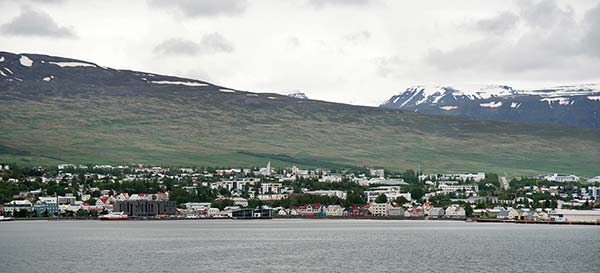
Though a perfectly pleasant place, Akureyri doesn’t have a lot of sightseeing. On a quick trip around the Ring Road, it’s best as a handy stop for a meal and a short stroll. With a little more time, poke into its striking church, wander its botanical gardens, or enjoy its large thermal swimming pool complex (both the botanic gardens and the pool are open late). And if you’re interested in whale watching, this is one of the places in Iceland to do it (though it’s arguably better in Húsavík, a bit farther along the Ring, and easier in Reykjavík).
Whether you’re coming directly across the mountains from Skagafjörður, or around the top of Tröllaskagi, you’ll approach Akureyri on southbound highway 1. This main road carries you right through the center of town, and then turns to cross the fjord just by Akureyri’s airport.
Tourist Information: You’ll find Akureyri’s TI in the Hof conference and cultural center, a striking, round, brown building—you can’t miss it as you drive in. The staff is helpful and well-informed, and you can pick up brochures for all of Iceland (June-late Sept daily 8:00-18:30, late-Sept-May until 16:00, closed Sat-Sun in winter, Strandgata 12, tel. 450-1050, www.visitakureyri.is).
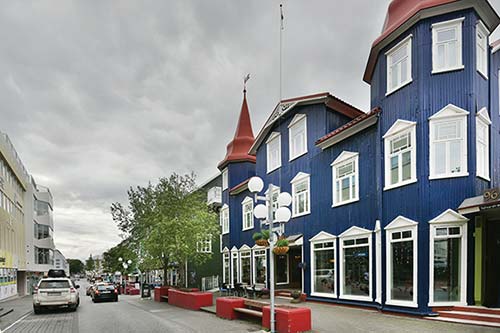
Parking: Lots in downtown Akureyri require that you put a little blue cardboard clock (called a bifreiðastæðaklukka, or klukka for short) on your dashboard showing the time you arrived (signs clearly indicate the maximum stay; enforced Mon-Fri 10:00-16:00). If you need a clock, ask at the TI, a local gas station, or a bank.
Begin by exploring the vest-pocket town center, a pleasant grid of not quite traffic-free streets lined with good restaurants and touristy shops (including branches of Eymundsson bookstore, Rammagerðin gift shop, and clothing stores 66° North and Geysir). It takes just a few enjoyable minutes to wander here and get your bearings. With ample time and a desire to go for a long, level stroll, head right (as you face the fjord) and walk along the water, past some traditional architecture, all the way to Akureyri’s mini Pond and sports arena, then loop back.
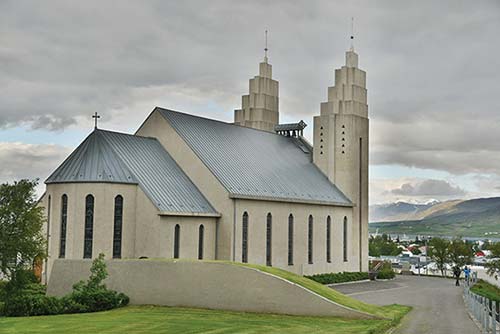
With less time, head up rather than out: In the town center, with your back to the water, you’ll see steps leading up to the hill-capping Lutheran Akureyri church (Akureyrarkirkja), with Art Deco lines and a crushed-volcanic-rock facade.
Akureyri’s top attraction is its botanical garden. This city park—compact but smartly designed and impeccably maintained—showcases northern plants (all labeled). Its pleasant, recommended café, in the middle of the park, is a handy landmark. Uphill (away from the waterfront) and to the left, you’ll find a little alpine garden, with mountain flora planted in a pretty rockery. Downhill from the café is planted with lusher Icelandic and Arctic flora.
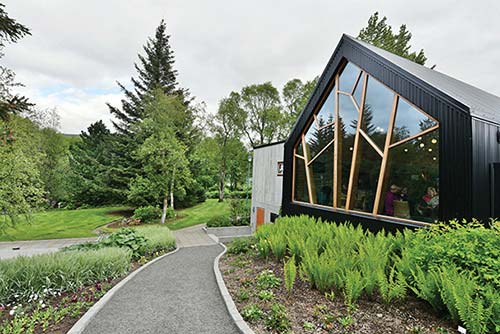
Cost and Hours: Free, open daily June-Sept, between Eyrarlandsvegur and Þórunnarstræti, free parking by the east (main) and west entrances, tel. 462-7487, www.lystigardur.akureyri.is.
Akureyri’s fine thermal swimming pool has extensive outdoor areas, including an ambitious waterslide. If you have yet to try an Icelandic pool, this sprawling complex is a fun place to start.
Cost and Hours: 900 ISK, June-Aug Mon-Fri 6:45-21:00, Sat-Sun 8:00-19:30, shorter hours off-season, corner of Þingvallastræti and Þórunnarstræti at the top of town (east of the botanical garden), parking lot just south on Hrafnagilsstræti, tel. 461-4455.
If you have the time, consider one of Akureyri’s many good museums. Top of the list is the aviation museum (Flugsafn Íslands), in a building at the airport (June-Sept daily 11:00-17:00, Oct-May by appointment, tel. 461-4400, www.flugsafn.is). There’s also a city history museum, an engineering museum, and a motorcycle museum. For details, ask at the TI.
Whale watching and other excursion boats line up at the waterfront. It’s best to book ahead—well-established companies include Elding (www.elding.is) and Ambassador (www.ambassador.is). Expect to pay around $100 for a classic three-hour cruise (double that for a high-speed RIB trip).
Akureyri is also a hub for day trips (by boat or plane) to the little island of Grímsey, just north of the Arctic Circle (see the “Islands in North Iceland” sidebar, earlier).
An excursion can make it easier to link up Akureyri with the worthwhile sights around Mývatn. Star Travel (www.startravel.is), The Traveling Viking (www.ttv.is), and Saga Travel (www.sagatravel.is) all run day tours (around $200).
You could do worse than sleeping in Akureyri, which feels like a return to civilization for Ring drivers. The town is also a good base for day trips: Head to lake Mývatn one day, to Siglufjörður the next, and so on.
In the Center: $$$$ Hótel Kea is a classic address with 104 business-class rooms right downtown, putting all of Akureyri at your doorstep...but you’ll pay royally for the privilege (very slushy rates, elevator, Hafnarstræti 87, tel. 460-2000, www.keahotels.is, kea@keahotels.is). $$$ Icelandair Hótel Akureyri, with 100 well-designed rooms, offers big-hotel comfort at more reasonable prices. It’s in a residential zone up at the top of town, across from the swimming pool (breakfast extra, Þingvallastræti 23, tel. 518-1000, www.icelandairhotels.com, akureyri@icehotels.is). ¢ Akureyri’s official youth hostel has 49 beds (Stórholt 1, tel. 462-3657, www.hostel.is, akureyri@hostel.is).
Cheaper Options Outside Town: In the idyllic countryside 10 minutes south of Akureyri, $$ Lamb Inn is on a working family farm called Öngulsstaðir. It rents 24 straightforward rooms in a converted cowshed, most with simple, prefab-like bathrooms (but some cheaper rooms with shared bath). They have a hot tub for guests, and a good dinner-only restaurant serving lamb raised right here (Öngulsstaðir 3, tel. 463-1500, www.lambinn.is, lambinn@lambinn.is). $ Lónsá, a suburban farm on the northern edge of town, is a 13-room guesthouse with shared bath, a guest kitchen, lounge, and laundry facilities. The lodgings are quite basic, but clean. In old-fashioned Icelandic style, you get a better rate if you bring your sleeping bag—you get a pillow, pillowcase, and bottom sheet, and can pay extra for a towel (tel. 462-5037, www.lonsa.is, lonsa@simnet.is).
In the Town Center: To get a taste of Akureyri, window-shop menus at the dozen or so eateries—ranging from a hot-dog wagon or fish-and-chips to Tex-Mex or curry.
For a cozy, casual space, look for $$ Kaffi Ilmur (“Aroma Café”), filling an old house on a hillside a few steps above the main grid of streets (daily 8:00-23:00 in summer, lunch-only in Oct-May, Hafnarstræti 107b, tel. 571-6444, www.kaffiilmur.com).
$ Berlín, with a cozy, tight, hipster vibe, is popular for breakfast and lunch (cheap salads and sandwiches, daily 8:00-18:00, Skipagata 4, tel. 547-2226).
Nearby, you can ride an elevator to the top floor of a downtown high-rise (which, here in Akureyri, means just five stories) to $$$ Strikið, a modern Nordic bistro with an eclectic menu. While quite pricey at dinner, they offer good lunch specials with a view (daily 11:30-22:30, Skipagata 14, tel. 462-7100, www.strikid.is).
And for top-end dining, $$$$ Rub 23 has a reputation even among Reykjavík urbanites for its grill-focused Asian-fusion food (Mon-Fri 11:00-14:00 & 17:30-22:00, dinner-only Sat-Sun, across the street from the church steps at Kaupvangsstræti 6, tel. 462-2223, www.rub23.is).
In the Botanical Garden: At the center of the gardens is $ Café Laut, serving sandwiches, salads, and soup in a striking picture-windowed building (late May-late Sept daily 10:00-20:00, closed off-season, Eyrarlandsvegur 30, tel. 461-4601).
Supermarket: Bónus is along the main road as you drive into town from the west (Langholt 1). There’s also Nettó, in the Glerártorg mall, also along the main road.
Akureyri is a transportation hub for the north and is well-connected to Reykjavík by bus (2/day, 1/day on Sat, 6.5 hours, www.straeto.is). You can also fly from Reykjavík into the Akureyri airport, which is about two miles from the center (car rental and taxis available; look for flights at www.airicelandconnect.com).
In summer (June-mid-Aug), other bus connections may be useful, but they don’t work for a same-day round-trip: Once daily, a bus leaves in the afternoon for Mývatn (3.5 hours), then continues on to Egilsstaðir (a hub for the Eastfjords, 5.5 hours).
To reach the fun little fjordside town of Siglufjörður and its Herring Era Museum, in summer three daily buses allow for a same-day return (1.5 hours each way; for the best views, sit on the right on the way up, and the left on the way back).
Off-season, all bus schedules are reduced. Long-distance buses stop at the Hof conference and cultural center, by the TI.
It’s about 60 miles/75 minutes from Akureyri to Mývatn.
Leaving Akureyri: From Akureyri, highway 1 crosses the fjord by the airport and turns north along the opposite shore (pullouts offer views across the fjord to the city). After about 20 minutes, the road climbs steeply away from the fjord and crosses the first pass of the day, Víkurskarð (1,100 feet). Víkurskarð is treacherous in snow; a toll tunnel called Vaðlaheiðargöng, which barrels straight under the mountain, is under construction. It may be open by the time you read this, but in good weather, I’d take the scenic pass rather than paying for the tunnel, which only saves a few minutes.
• After about 45 minutes, you’ll reach...
Goðafoss Waterfall: This ▲ pretty, horseshoe-shaped waterfall is not so high (only 40 feet), but it is quite broad (30 yards). It’s right along the main road, there’s free parking (as well as a big shop with the uninspired $ Fosshóll Café), and it takes just a couple of minutes to walk to the best views. The pedestrian bridge here was once the main road. People enjoy scrambling across the tidepool-like rocks at the top of the falls.
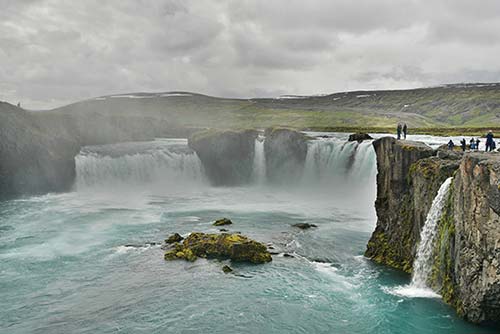
This waterfall plays a role in the sagas. In A.D. 1000, the law speaker of the Alþingi made a momentous decision: Þorgeir Ljósvetningagoði, whose home farm (Ljósavatn) was in this area, was assigned to choose whether Iceland would remain pagan or (under great pressure from Norway) become Christian. Þorgeir chose to have Iceland convert, and to fully own up to his decision, he became a Christian, came home, and threw his carved pagan statues into this waterfall—giving it the name “Waterfall of the Gods” (Goða-foss). For more on Þorgeir, see here.
• From Goðafoss, the road climbs over a low pass called Fljótsheiði (800 feet) and drops down to the small settlement of Laugar, with hot springs and a high school.
Laugar to Mývatn: There’s not too much to see in this sparsely populated countryside. You’ll pass a few farms and drive along the shore of a desolate lake, then along a small river, Laxá. The river is famous as the site where, in 1970, almost two hundred locals took matters into their own hands and blew up a small, controversial dam they had opposed. Over a hundred individuals “confessed” to the crime and refused to say who did what, making prosecution difficult.
• About an hour from Akureyri, you’ll reach the junction of highways 1 and 848. Carry straight along on highway 848.
You’re just west of lake Mývatn. From here, follow highway 848 counterclockwise as it loops around the south and east shore of the lake, with several attractions (described next).
From Mývatn, it’s a 45-minute detour north on highway 87 to the bayside town of Húsavík (described on here).
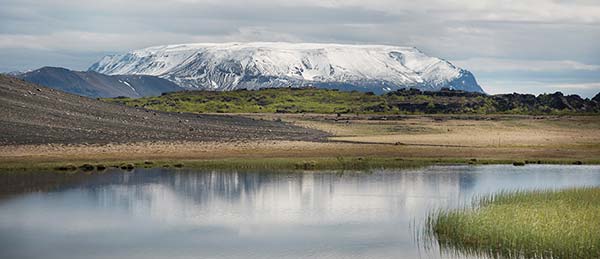
Mývatn (MEE-vaht; n almost silent—literally “Midge Lake,” after the tiny gnats that thrive here) is one of Iceland’s most impressive natural areas. The lake itself—about 14 square miles, broad and shallow—has an intriguingly ragged coastline, with lots of bays and islets. Better still, it’s ringed by a delightful array of volcanic features, from bubbly pseudocraters to otherworldly pillars to a climbable volcanic cone.
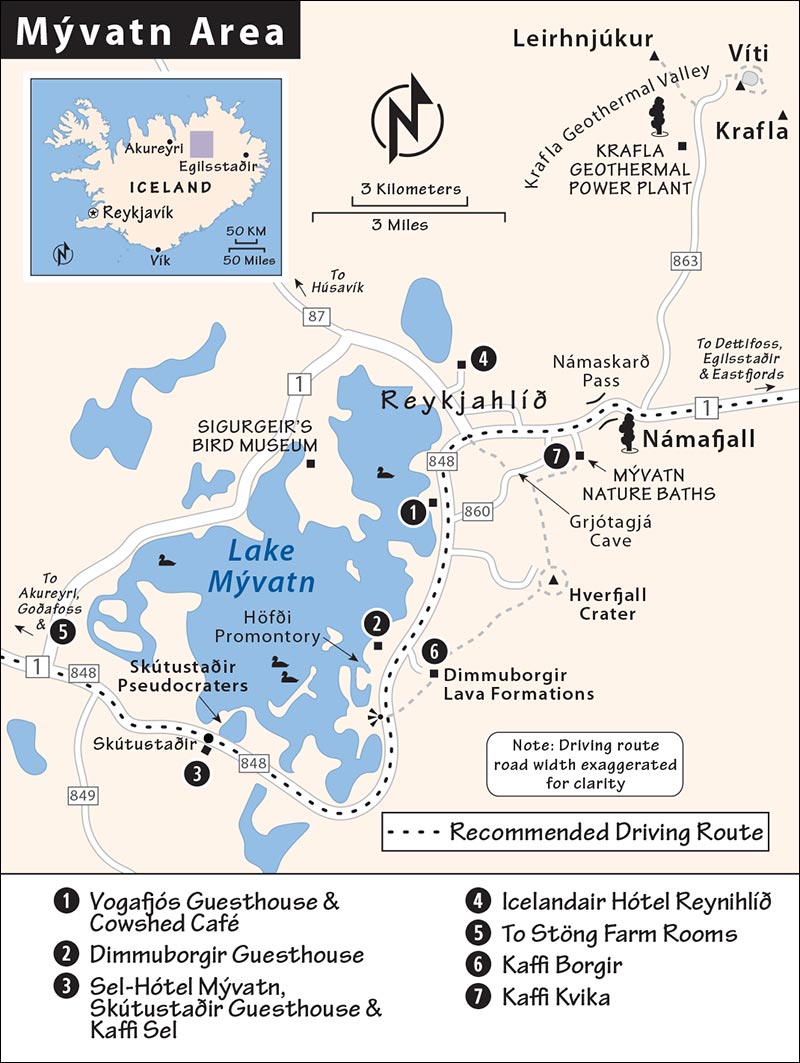
A short drive away are even more sights, including a geothermally active valley and one of Iceland’s best premium thermal baths. The entire area is ringed by striking flat-topped mountains, making it feel like the setting for an interplanetary science fiction epic. With its accessible size, remote location, and diversity of easy nature hikes, Mývatn feels like Iceland’s Yellowstone; many visitors hail it as their favorite area of all.
Note that the Mývatn area lacks a real town, but the appealing small town of Húsavík is just a 45-minute drive north. Húsavík is worth a detour (and can be a good place to stay, if Mývatn is full or if you’re interested in whale watching; see here).
“Mývatn” is the name of the lake, but also refers to the entire area (which Icelanders call Mývatnssveit). Sights are scattered around the lake, which is ringed by two roads. Highway 1 runs along the east and north side, with few sights other than Sigurgeir’s Bird Museum. Highway 848, on the south and east sides, is more interesting, especially along the 10-mile stretch between the hamlets of Skútustaðir and Reykjahlíð. Another cluster of sights lines the stretch of highway 1 that runs east away from the lake, toward the Eastfjords.
Most settlement around the lake is on dispersed farms. Reykjahlíð (RAKE-ya-HLEETHE, “Smoky Hills”), at the lake’s northeast corner, is the closest Mývatn comes to having a village. It has a small supermarket and fast-food stand, bank, gas station, health center, and a few streets of houses. Skútustaðir (SKOO-tu-STAHTH-ear), on the southern shore, is just a church, hotel, convenience store, and gas pumps, next to a farm.
Tourist Information: Locals are generous with tips, and the website VisitMyvatn.is is helpful.
Navigation Note: Google Maps makes some errors in this area; supplement with printed maps or the local website Ja.is.
Tours and Activities: In the parking lot of Icelandair Hótel Reynihlíð, Mývatn Activity rents bikes and can arrange bike, hiking, and jeep tours as well as other activities (tel. 899-4845, www.myvatnactivity.is). Mýflug Air runs sightseeing flights over the region (www.myflug.is). Various local companies offer horseback riding (Saltvík: www.saltvik.is; Safari Horse Rental: http://safarihorserental.com). If you stay longer in the region, several operators offer day trips to the giant Askja volcanic caldera, deep in the Highlands south of Mývatn, which you can reach only in a 4x4 vehicle (Fjallasýn: www.fjallasyn.is; Mývatn Tours: www.myvatntours.is).
Eating: This area has no real “destination” restaurants, but I’ve listed a few practical choices mixed in with the sights. Try to sample two local products that are often served together: sweet, dark-rye bread that’s buried underground and baked with natural thermal heat, then topped with decadent, smoked lake trout.
Dealing with Midges: You may want to wear a net to protect yourself from midges flying into your nose, ears, or mouth (see sidebar, previous page). You can bring one from home or buy one locally (sold at area supermarkets). Don’t bother using insect repellent: The bugs aren’t out to bite you—they’re just a nuisance.
These attractions ring the lakefront. I’ve listed them in the order you’ll encounter them driving counterclockwise from Skútustaðir (southwest) to Reykjahlíð (northeast) along highway 848.
At the tiny settlement called Skútustaðir, you reach the first of many striking volcanic sights at the lake. Park at the lot (across from the big Sel-Hótel Mývatn) and spend 20 minutes walking the half-mile “Crater Trail,” between the road and the lake, through the pseudocraters (also called “rootless cones”). These are not real volcanic craters. They’re all that’s left of what had been giant bubbles in molten lava: Water under the lava boiled into steam, rose to the surface, and popped. Metal stairs lead up to the rims of several of the craters. A longer path here (“Bird Trail,” 1.5 miles) takes an hour.
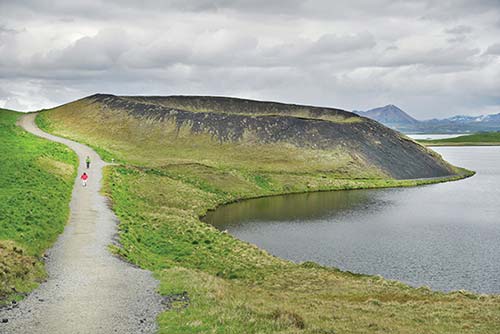
Eating at Skútustaðir: Located in the hotel’s parking lot, $ Kaffi Sel serves cheap, simple grill meals and a handy, lunchtime soup-and-bread buffet (daily, tel. 464-4164, www.myvatn.is). The restaurant inside $$ Sel-Hótel Mývatn has a more substantial lunch buffet for about double the price (daily).
• To continue around the lake, follow the lakeside road counterclockwise. Within a few miles you’ll leave grassy rolling hills and enter a lunar landscape covered by a petrified lava flow. Watch on the left for a pullout overlooking a lagoon that’s filled with serrated lava islands. As you look out over the water, notice the wooded peninsula to the north (on your right). This is...
For years, a local couple worked to reforest this small peninsula, and laid out sheltered walking trails with views of the lake and the lava columns that rise up from it. It has its own parking lot (just beyond the pullout mentioned above) and makes a nice 30-minute stop on a pleasant day. If you come on a calm summer day, you may see more insects than you ever have in your life. Wear a net, or prepare to spit midges; they don’t bite, and the swarms are actually kind of impressive.
• On the land side of the road, a little farther north (toward Reykjahlíð), is the next stop.
Literally the “Dark Castles,” this area is a fantasyland of spectacular pillars and crenellated formations. It’s the most satisfying place around the lake for an easy nature walk, and it’s fun for kids. The Dimmuborgir (DIM-moo-BOR-geer) formations originated when everything here was underwater. From the lake bed, magma leaked upward and solidified, forming spiky, stalagmite-like columns. Well-marked, paved trails lead through Dimmuborgir; study the posted map to plan a route for the amount of time you have. The shortest walk takes only 15 minutes, but you could easily spend two hours here. Entrance and parking is free (pay WC at the café), and if you visit early or late, it will be less crowded.
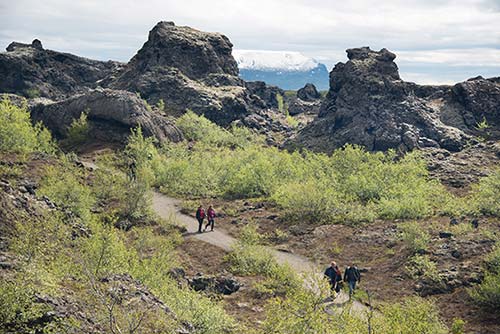
Eating at Dimmuborgir: In the Dimmuborgir parking lot, $$ Kaffi Borgir has a soup-and-bread lunch buffet and a short menu of main dishes. If you can handle the midges, their outdoor seating is atmospheric (daily 10:00-21:30, closed off-season, tel. 461-1144, www.kaffiborgir.is).
This vast, dry volcanic crater (HVER-fyahtl, sometimes spelled Hverfell) rises just east of the lake—you can’t miss it. A short gravel road (watch for Hverfjall signs) leads 1.5 miles along a rutted gravel road off highway 848 to a free parking lot (pay WCs, credit card only). From the parking lot, a path leads up the side of the mountain to the rim, where there’s an excellent view down into the broad crater and back toward the lake. The hike up is a good workout, but isn’t too steep and takes about 20 minutes one-way. In strong winds, the walk up isn’t much fun, and the loose soil can start to fly around; otherwise, it’ll reward your effort.
Eating near Hverfjall: Just north along the road toward Reykjahlíð is $$$ Cowshed Café, with a country-kitschy vibe and tasty homemade cooking; it’s my favorite choice for a meal in the area (it’s part of the recommended Vogafjós Guesthouse). It’s in a barn, with views of the lakeshore and mooing cows—you can ask to see the milking area (daily 11:00-22:00 in summer, may close earlier off-season, tel. 464-3800, www.vogafjos.is).
• The next stop is best reached from highway 1 (see complete directions below).
Tucked in the middle of nowhere a few minutes’ drive from the lake is a hidden cave filled with natural thermal waters. It gets more attention than it deserves for being a filming location for Game of Thrones (the romantic retreat where Jon Snow and Ygritte, ahem, violated the oath of the Night’s Watch). While skippable for most, curious GoT fans may find the brief detour justifiable. You’ll walk to a crevasse, where extremely uneven, rocky footing leads down to a steaming pool. Watch your step—this is at your own risk, with no guardrails or barriers—and actually getting in the water is forbidden. While this feels impossibly remote, you’ll likely see a steady stream of bus tours stopping here.
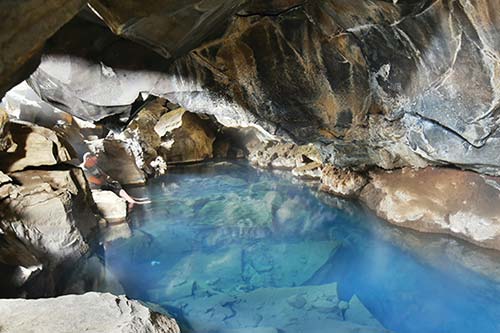
Getting There: Even though it’s on road 860, Grjótagjá is most easily accessed from highway 1, just east of the lake but before the turnoff for Mývatn Thermal Baths; watch for the small Grjótagjá sign. From the turnoff, it’s a quick 1.5-mile drive. Note that road 860 continues (unpaved) from the cave all the way to Mývatn’s east shore (near Vogafjós Guesthouse); this can be a handy shortcut, but you’ll need to let yourself through a gate.
Mývatn is famous among birders, who have observed more than 115 species here (including 30 different types of ducks)—making it one of the richest birding areas in the world. This museum offers an opportunity to examine hundreds of taxidermied specimens up close (as well as an extensive egg collection). Display cases show off a striking diversity of birds, including nearly every bird found in Iceland and many who migrate here to breed. Webcams and telescopes let you observe living birds on the lake, and the staff loves to advise visiting birders. A second, smaller building displays artifacts from the Mývatn area, including a boat once used to ferry passengers across the lake.
The collection is named for avid birder Sigurgeir Stefánsson, who lived on this farm and collected most of the specimens you see (usually birds that were already dead). Nature did not return his kindness, as at age 37, Sigurgeir drowned during a freak storm on the lake. But his legacy—and his passion—live on here.
Cost and Hours: 1,200 ISK, June-late Aug daily 9:00-18:00, late May and late Aug-Oct daily 12:00-17:00, shorter hours off-season, on-site café, on road 8735 at the farm called Ytri-Neslönd—signposted off highway 1, tel. 464-4477, www.fuglasafn.is.
On and near highway 1 going east from the lake are several other worthwhile attractions—most of them related to the geothermally alive landscape. You might find it simplest to fit these in on your way from Mývatn to the Eastfjords, but it’d be a shame to rush them. Since they’re all within 10 miles of the lake, you can easily double back if you’re staying nearby.
• Just off highway 1, five minutes from Reykjahlíð (and before Námaskarð pass), you’ll come to...
This premium swimming pool is one of Iceland’s most appealing thermal bath experiences. Imagine the Blue Lagoon, but a bit more modest, less crowded, and about half the price. The baths’ outdoor lagoon is beautifully designed: two big pools with natural contours, rocky walls, pebbly bottoms, and fine views over the volcanic countryside (black rock, steaming vents, and distant lake views). Like the Blue Lagoon, the water here is naturally heated excess from a nearby geothermal power station (at Bjarnarflag); unlike the Blue Lagoon, the water here isn’t salty, has no silica suspended in it, is more white than blue, and has a slightly sulfurous odor. The nature baths are open late, making it an ideal way to unwind after a long day driving the Ring or exploring Mývatn. It’s not quite luxurious or spa-like (no swim-up bar, no mud masks, no private shower cabins), but for many, these baths are a just-right Goldilocks compromise between the expense and pretense of the Blue Lagoon and the austere functionality of standard municipal pools. Locals enjoy it, too.
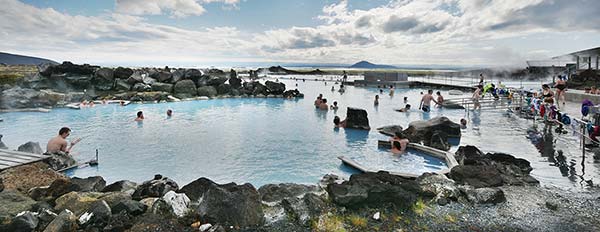
Cost and Hours: 4,300 ISK, towel rental-700 ISK, daily late May-Sept 9:00-24:00, off-season 12:00-22:00, they don’t take reservations, often referred to as Jarðbaðshólar on maps and signs, tel. 464-4411, www.myvatnnaturebaths.is.
Visiting the Baths: The modern entry building has free parking, a nice café, free WCs even for nonbathers, and a view deck overlooking the pool. Buy your ticket (prepay for a drink, if you like), find your way to the simple locker room, shower, and stow your clothes. It’s best to remove easily tarnished jewelry and glasses or other delicate lenses, which can be damaged by the water’s minerals (for more on best practices at thermal pools, see here). Then head outside and lower yourself into the steaming water, which is highly alkaline and slightly milky. Temperatures range from 34°C to 41°C (93-105°F), with hot and cool spots around the pool. Explore, float, and relax. If you bought a drink, flag down an attendant to bring it to you. The two steam baths, in little sheds around the pools’ perimeter, vent natural geothermal steam through the floor at a temperature of about 50°C (122°F).
Eating at the Baths: The complex has a good cafeteria, $ Kaffi Kvika (“Magma Café”), with indoor and outdoor seating overlooking the lively lagoon (no bath ticket required). As this is essentially your “last-chance lunch” (other than picnicking) between here and the Eastfjords, consider stopping on your way out of the area (open same hours as pool). You’re not allowed to eat your own food on the premises.
• Just five minutes beyond the baths, you’ll crest the small Námaskarð pass. Watch on the right (after the steep initial climb) for a pullout with a commanding panoramic view over the entire Mývatn area. Coming down the other side of the pass, a turnoff on the right leads in a couple hundred yards to a parking lot for the...
The steaming, bubbling, brightly colored landscape of Námafjall (NOW-mah-fyahtl)—which is also sometimes called Hverir (“Hot Springs”) or Hverarönd—is one of Iceland’s most accessible and impressive geothermal areas. While it lacks a spouting geyser, it’s more colorful and more interesting (and in a more impressive setting, ringed by mountains) than Geysir on the Golden Circle—and it’s far less crowded, with very few ropes and signs (be careful and stay on the trodden paths).
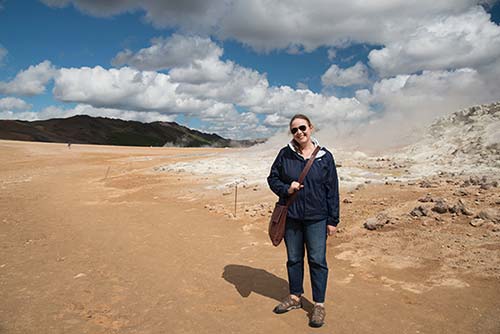
Park and step outside—getting slapped in the face with pungent hydrogen sulfide fumes. Then plug your nose and explore this compact, astonishingly diverse landscape. You’ll see fumaroles (like little stacked-rock ovens spitting steam), bubbling pools, and a terrain brushed in a rainbow of vivid colors. The mountainside just beyond the plain also has steaming vents; with extra time, you can hike up the trail for a closer look and for views back over this landscape. The sulfur deposits in this area were once mined for gunpowder (náma means “mine”).
• A quarter-mile farther on, detour onto paved highway 863 (to the north). This five-mile-long road passes through a steaming landscape, linking several worthwhile attractions.
The volcano Krafla (KRAH-plah), at the end of this valley, was active as recently as the 1980s; now the valley is the site of a geothermal power plant (notice the pipeline and electric cables on your left).
• As you head up the valley, keep an eye out on the right for a...
Showerhead: Sticking up from the ground, a single showerhead stands lonely in the middle of a volcanic plain. It appeared overnight several years ago—perhaps as a prank or art installation—but it really is hooked up to natural thermal water; you may see it being used by campers and hikers who can’t afford the pricey thermal-baths complex.
• Continuing up the valley, you can’t miss the simmering...
Krafla Geothermal Power Plant: This plant taps into superheated liquid deep underground. Its modest, summer-only visitors center has exhibits and a brief film about Iceland’s geothermal plants (free entry, WCs, and coffee; June-mid-Sept daily 10:00-17:00, closed off-season).
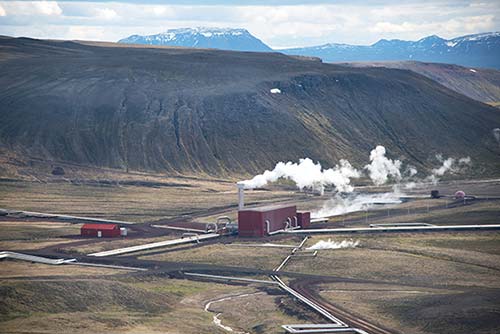
• After leaving the power station, there’s a parking lot on the left at the head of a marked path that takes you across a lava field to the...
Leirhnjúkur Volcanic Cone: Meaning literally “Clay Peak,” this low volcanic cone formed recently in eruptions around 1980. Volcano buffs enjoy the full hiking circuit here—all the way around the mountain. It takes about three hours and includes colorful pools, still-steaming lava formations, and more. To get a quick feel for the place, walk out to the mountain and back (about 15 minutes each way, partly on boardwalks); you’ll see some mud pots and fumaroles. The footing can be slippery—if you value your shoes (and feet), stay on the marked paths.
• Continuing on the main road past the Leirhnjúkur parking lot, look for a pullout on the right with a stunning view back over the valley. Then drive to the end of the road and the...
Víti Crater: This unearthly volcanic crater with a lake inside was formed during eruptions in the 1720s. You’ll park virtually next to the rim, with fantastic views over the colorful walls and water. From here, a path leads all the way around the crater. Víti (“Hell”) is big, wild, and an altogether powerful and forbidding sight. Don’t go down to the water, which is hot.
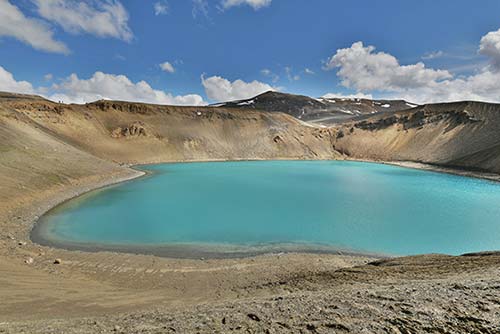
The sparsely populated communities that ring the lake have a handful of accommodations, but not enough to cater to the increasing summertime crowds. While this is a delightful area to spend the night, reserve your rooms well ahead, as hotels can book up very quickly. If things are booked solid, stay in Húsavík—a pleasant waterfront town a 45-minute drive north (described later). You can also try checking back to see if you can fill a cancellation. Camping is allowed only at designated sites.
On the Eastern Shore: Near all the major attractions, $$$$ Vogafjós Guesthouse is a family-run working farm with 26 good, tidy rooms in three new prefab wooden buildings. Reception is at the recommended Cowshed Café restaurant (tel. 464-3800, www.vogafjos.is, vogafjos@vogafjos.is). $$ Dimmuborgir Guesthouse has eight simple rooms (with private bathrooms and a shared kitchen) in a main building, as well as prefab wooden cottages (all with private bath and kitchen). It’s loosely run but family-friendly, and they catch and smoke their own fish (2-night minimum in summer, Geiteyjarströnd 1, tel. 464-4210, www.dimmuborgir.is, dimmuborgir@emax.is).
On the Southern Shore, at Skútustaðir: Family-run but characterless, $$$$ Sel-Hótel Mývatn has 58 expensive rooms that feel designed for tour groups and conferences. It’s right next to the pseudocraters, with a shop, café, and restaurant on-site (elevator, tel. 464-4164, www.myvatn.is, myvatn@myvatn.is). $$ Skútustaðir Guesthouse, tucked behind the Sel-Hótel complex, rents 15 modern rooms (10 of which share bathrooms, 5 with private bathrooms) in a mix of old and new buildings, plus a standalone cottage (tel. 464-4212, www.skutustadir.is, info@skutustadir.is).
On the Northern Shore, at Reykjahlíð: Bragging that it’s the “oldest country hotel in Iceland,” $$$ Icelandair Hótel Reynihlíð has 41 modern, hardwood rooms, along with a restaurant, comfy lounge with piano, and sauna for guests (tel. 464-4170, www.icelandairhotels.com). Note: This is different from the Hótel Reykjahlíð, an older option nearby.
In the Countryside to the West: An authentic farm, $$ Stöng is a couple of miles down an unpaved side road, on the way from Goðafoss to Mývatn. Their two dozen rooms are spread among a main building (from the 1920s), a motel, and cottage-style outbuildings. It’s not as spiffy as other options, but it’s less expensive and guests can use the hot tub. Older rooms in the main building have a shared bath; private-bath rooms are more modern but still basic (closed Nov-March, restaurant with pricey traditional dinners, tel. 464-4252, mobile 896-6074, www.stong.is, stongmy@stong.is).
Húsavík (HOOS-ah-VEEK, pop. 2,200), north of Mývatn, is a pretty town with a nice harbor facing the fjordlike Skjálfandi bay. For visitors with time to linger, Húsavík offers a pleasant real-town vibe, appealing restaurants, a good swimming pool, a colorful town church, a good whale museum, and some of Iceland’s best whale watching. If you’re enjoying long summer days and want to take a dinnertime side-trip, Húsavík is pleasant enough to warrant the drive from Mývatn. Húsavík is also a good fallback home-base when rooms around Mývatn are all booked up.
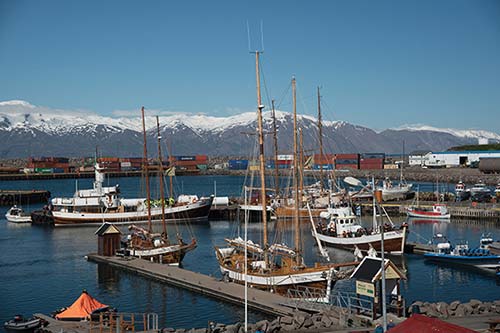
Getting There: Húsavík is about a 45-minute drive (35 miles) from Mývatn, north on highway 87 from near Reykjahlíð. As you leave the lake area, you’ll pass through a bulging volcanic landscape; you can see clearly where the undulating lava buckled and bubbled as it cooled. Then you’ll traverse a stark, desolate terrain, with little settlement and several stretches of unpaved road. Eventually you run into the picturesque Skjálfandi bay, turn right onto highway 85, and carry on into town.
Orientation to Húsavík: This little town is simple. The main road coasts downhill to the town center and a handy parking lot on the harbor. Everything I mention is within a five-minute stroll. The Húsavík Whale Museum ticket desk serves as a basic town TI, with maps and brochures (see www.visithusavik.com).
Facing the Greenland Sea and about as far north as you can get in Iceland (next stop: Arctic Circle), Húsavík is one of Iceland’s top whale watching destinations, with the best likelihood of actually seeing a whale. Several well-established companies have sales kiosks overlooking the hardworking harbor. Options range from classic old wooden boats to high-speed RIBs (rigid inflatable boats). A standard three-hour trip costs around 10,000 ISK. The main operators include North Sailing (www.northsailing.is), Gentle Giants (www.gentlegiants.is), and Salka Whale Watching (www.salkawhalewatching.is). If your time in this area is limited, consider whale watching from Reykjavík or Akureyri.
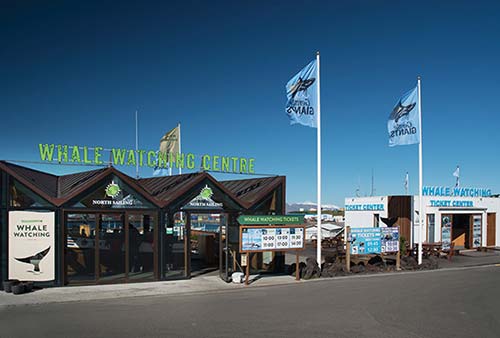
This thoughtful museum offers an informative look at the whales that fill the waters around Iceland. Though fairly dry and scientific, the exhibits are good, with miniature models of whales, an actual jawbone of a sperm whale, a display on seabirds, a one-hour Giants of the Deep film, and several good children’s areas. But the museum’s highlight is hanging from the rafters upstairs: the skeletons of 11 different whale species, including narwhal, sperm, humpback, orca, and pilot. The biggest skeleton—in the side hall on the main floor—is an 80-foot-long blue whale. These specimens were not hunted, but washed up on beaches, then removed and processed by the museum. (Anytime a beached whale corpse appears around Iceland, locals call the museum to come cart it away.) Rounding out the exhibits are art installations related to whales and an unapologetic overview of the history of whaling in Iceland, including a film with archival footage of workers processing and rendering slabs of blubber.
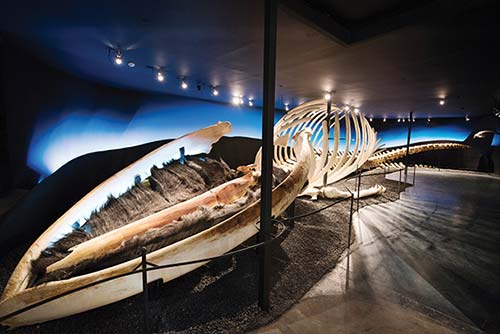
Cost and Hours: 1,900 ISK; generally daily May-Sept 8:30-18:30, Oct-April 10:00-16:00, closed Sat-Sun in Nov-March; Hafnarstétt 1, tel. 414-2800, www.whalemuseum.is.
Húsavík’s unusually colorful and interesting town church dates from 1907 (you can’t miss it along the main street as you come into town). Stepping inside, it’s clear this church was designed by shipbuilders: Stout beams intersect in the middle of the ceiling, like perpendicular boat hulls, all painted in cheery colors. Rather than a pulpit, there’s a simple lectern, shaped like an open book. Notice the c. 1930 painting over the altar depicting the resurrection of Lazarus...but set in Iceland (see the backdrop of lava rock).
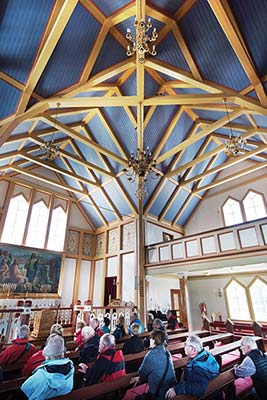
Sleeping in Town: Youthful but accessible, $$ Port Guesthouse fills a renovated former fish factory with 10 rooms (all with shared bathrooms). It has shipshape wood-pallet furniture, a cozy lounge, and amazing views over the busy port and mountains across the fjord—you’ll pay a bit extra for a view (breakfast extra, Garðarsbraut 14, tel. 464-0255, www.port-guesthouse.com). $$ Árból Guesthouse, a couple of blocks up from the harborfront, has 10 contemporary rooms with shared bathrooms in a fine, creaky old house (Ásgarðsveguri 2, tel. 464-2220, www.arbol.is, arbol@arbol.is); they also have six studio apartments across the street.
Sleeping Outside Town: $ Kaldbaks-Kot is a lovely little country-cutesy compound of 17 simple wooden cottages (sleeping 2-10 people, all with private bathrooms and kitchenettes). It’s in a gorgeous setting, perched just above the bay a few minutes’ drive outside Húsavík (breakfast extra, tel. 892-1744, www.cottages.is, cottages@cottages.is). $$ Skógar Sunset Guesthouse, on a remote ridge along highway 87 (about 15 minutes south of Húsavík and 30 minutes north of Mývatn), has four tidy, well-constructed prefab rooms (with private bathrooms and kitchenettes) on a sleepy family farm (no breakfast, tel. 845-3757, ornsig66@simnet.is or book on Airbnb).
Eating in Húsavík: Overlooking the pier at the town’s main harborfront, $$$ Salka is a good all-around choice for high-end Icelandic cooking in a bright setting (daily 11:30-21:00, Garðarsbraut 6, tel. 464-2551). $$ Naustið, a block up in town, fills a bright yellow house and has inviting outdoor seating, but no views (daily 12:00-22:00, Ásgarðsvegur 1, tel. 464-1520).
It takes about two hours, nonstop, to drive the 110 miles from Mývatn to Egilsstaðir, the gateway to the Eastfjords. Though relatively short in terms of driving distance, this stretch takes you over a wild, uninhabited highland (at 1,700 feet) that can be snowy well into spring. The worthwhile detour to the impressive Dettifoss waterfall adds two more hours (one for driving, and another to hike around the falls). Coastal Seyðisfjörður, a more interesting place to overnight than Egilsstaðir, adds yet another 30-45 minutes of driving. So all told, expect about five hours en route from the shores of Mývatn to the shores of Seyðisfjörður.
Avoid the temptation to spend several extra hours taking the longer northern route (along highway 85) from Mývatn to Seyðisfjörður via Kópasker. Devote time to Iceland’s far northeast corner only if you’re spending several weeks here.
Be aware that blowing sand can sometimes kick up between Mývatn and Egilsstaðir; check the forecast before setting out.
• From the lakefront settlements around Mývatn (last chance for gas!), head east, passing Mývatn Nature Baths (last chance for food!). Then head over Námaskarð pass. Once you leave the Krafla Valley, there are no services (and virtually no civilization) along highway 1 for nearly two hours (though there are portable toilets at the Dettifoss parking lot).
If you haven’t yet, consider stopping off at the fascinating Námafjall geothermal area (easy to see quickly) or drive up the Krafla Valley to see the geothermal sights there (takes longer)—both are described earlier in this chapter, under “Mývatn.”
• About 12 miles (15 minutes) east of Krafla, watch for the turnoff on the left for paved highway 862. The parking lot for the Dettifoss falls sits about 15 miles (20 minutes) off the main road. (Note that there’s a second turnoff to Dettifoss a bit farther east—highway 864—which heads up the opposite, east side of the river and falls. This affords a slightly better view, but is accessed via a slow-to-drive gravel road. There’s no bridge across the river near the falls.)
Iceland’s most powerful waterfall, Dettifoss (DEH-tih-foss) is both broad (340 feet) and high (150 feet). Like Gullfoss on the Golden Circle, you’ll view it from above.
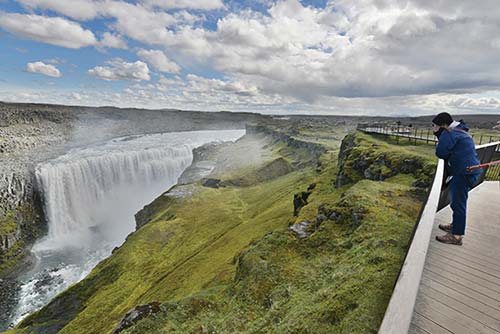
From the parking lot (free, always open, portable toilets), you’ll walk 15 minutes (about a mile) along a well-marked path to the overlook. The walk in—through a stony plain with basalt columns—is part of the fun. Finally you reach the falls, which thunder into their canyon, spitting up a misty cloud (often with a rainbow). There are two viewpoints: The lower one, on slippery rocks, gets you fairly close to the top of the falls. Then you can follow the trail up to the upper viewpoint, for the big-picture view.
A few hundred yards upstream from Dettifoss, on the same river, is a smaller waterfall called Selfoss. You’ll see the trail fork off on the left as you walk back toward your car. It’s about two-thirds of a mile—10 minutes—to the falls. The walk rewards you with epic views of the milky, strikingly wide Jökulsá á Fjöllum (“Glacial River in the Mountains”) as it flows between the two falls. The riverbanks are striped with bold, vertical basalt ledges—some of which are sloughing off—and a few black sand beaches are tucked between the rapids. This river flows 130 miles from the northern edge of the Vatnajökull glacier—Iceland’s largest—to the Greenland Sea.
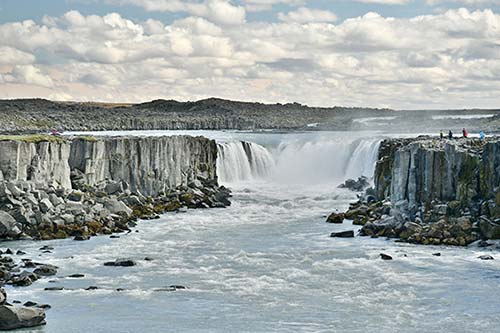
Downstream from Dettifoss is yet another waterfall, Hafragilsfoss, which is almost as broad and high as Dettifoss itself; it’s difficult to reach without a 4x4 vehicle, and best skipped.
• Leaving Dettifoss, return to the main road and continue east. After a few miles, you’ll cross a scenic white suspension bridge across Jökulsá á Fjöllum—the river that flows over the Dettifoss waterfall.
From here, it’s about 80 miles (1.5 hours) through a stark, almost lunar landscape, essentially Iceland’s “Big Sky Country.” This is a real Highland experience.
• As you proceed, keep an eye on your right for the tabletop mountain called...
Herðubreið: Iceland’s answer to Norway’s Pulpit Rock is a tuya—a steep, flat-topped volcano created when molten rock pushed up through a glacier. Just behind Herðubreið—but not visible from here—is Askja, a volcanic crater lake buried deep in Iceland’s interior, and one of the country’s most famous remote and scenic destinations.
If you’re in a pinch, there is one place for refreshment between Mývatn and Egilsstaðir, but it’s not directly on highway 1: About 24 miles (30 minutes) after the Dettifoss turnoff, watch on the right for road 901 to Möðrudalur. About five miles down this road is Fjalladýrð, a working farm with a campsite, guest rooms, a shop, views of Herðubreið, and the café $$ Fjallakaffi (tel. 471-1858, www.fjalladyrd.is).
• Continue along the desolate plain, with very little vegetation save for some parched, scrubby grasses.
Jökulsá á Dal Valley: Finally you wind your way down a picturesque, lush-green valley of Jökulsá á Dal (“Glacial River in the Valley”). Enjoy the scenery, following the turquoise river with waterfalls all around, as you drop down from the Highlands into the Eastfjords.
• Where the road bends and crosses the river, stay on highway 1 and drive toward the panorama of snowcapped peaks, eventually crossing the wide Lagarfljót river to the large town of...
Egilsstaðir (“Egill’s Farm”): This functional hub and gateway to the Eastfjords has gas stations and some decent places to eat or spend the night in a pinch. But for even better scenery and a legitimately charming town, continue on to Seyðisfjörður.
Your drive is not quite over—you’re 30-45 minutes from Seyðisfjörður. (For more on both towns and a map of the area, see the next section, “Eastfjords.”)
• From Egilsstaðir’s main intersection (at the N1 gas station), take highway 1 (marked Reyðarfjörður) and drive up through the residential part of town. After just a half-mile—as you crest the hill and leave town—turn left onto highway 93, marked Seyðisfj (with a ferry icon); almost immediately, be ready to turn right to stay on highway 93.
Over the Fjarðarheiði Pass: Here begins one of Iceland’s most scenic drives—the stunning road that summits Fjarðarheiði (“Fjord Heath”), the pass leading to Seyðisfjörður. (Note: This road is frequently snow-covered and sometimes closed in April and October.) You’ll curve up switchback after switchback, gaining altitude (and gasping at the lack of guardrails) before disappearing into an otherworldly landscape of mountaintop ponds. Icebergs bob in the big Heiðarvatn (“Heath Lake”), even well into summer. You’ll crest the pass at 2,030 feet, and then begin the slow, stunning switchbacks down to the fjord. The road wraps around on itself several times, tying neat little bows around craggy cliffs and gushing waterfalls. It’s often socked in, but when clear, this route offers breathtaking fjord-and-waterfalls views.
• Returning to sea level, you pull into artsy Seyðisfjörður—ready to explore.
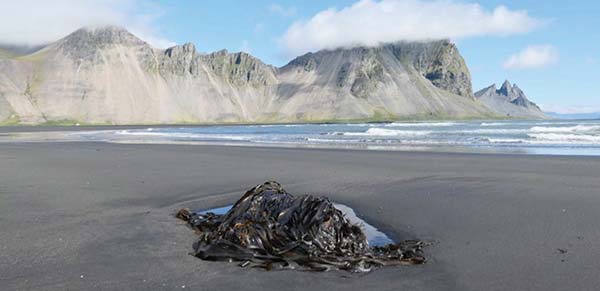
Iceland’s remote, sparsely populated east is as scenic as it is lonesome. Its coast is slashed with a dozen deep, steep fjords, with very few tunnels and no bridges to speed your progress. Wrapping around fjords is very slow-going, making this the most tedious (albeit scenic) stretch of the Ring Road. You can easily drive for miles and miles without ever seeing another car.
The main tourist draw here is the charming fjordside town of Seyðisfjörður—the most interesting stop, by far, in eastern Iceland, and the no-brainer choice for an overnight. To get there, you’ll pass through the practical population center of Egilsstaðir (lots of services and a possible place to sleep). The nearby long, skinny lake called Lagarfljót, with a few mediocre sights, may also be worth a stop. But with limited time, don’t linger here: From this area, you’ll turn south, tracing the long, jagged shoreline to Southeast Iceland and glorious glacier country.
Planning Tips: Seyðisfjörður, with its striking setting and excellent assortment of hotels and restaurants, is the best place to spend the night. Egilsstaðir is a good backup—and it cuts down on driving. Accommodations can be tough to find the night before the weekly Norröna ferry to Denmark departs from Seyðisfjörður (schedules at www.smyrilline.com)—but if you’re here that night, you’ll find these towns (especially Seyðisfjörður) particularly lively.
The workaday community of Egilsstaðir (AY-ill-STAHTH-ear, pop. 2,500) lacks Seyðisfjörður’s creative charm, but it enjoys a fine setting along the lovely Lagarfljót lake. It’s the largest community in the east, with a big swimming pool, supermarkets, and other services—making it a good place to stock up before your long onward journey.
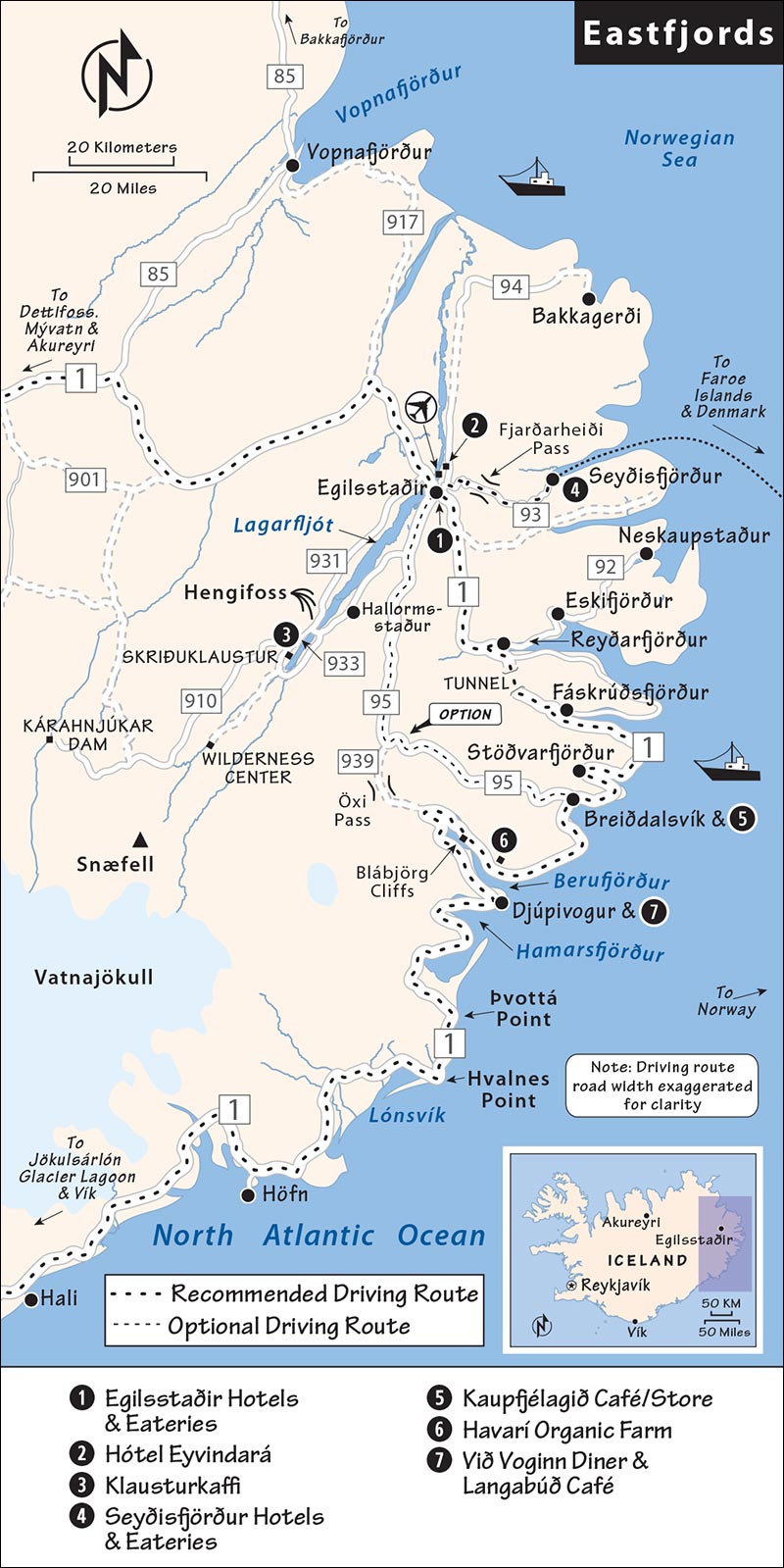
Tourist Information: Right along highway 1, you’ll find a regional TI (Mon-Fri 8:30-18:00, Sat 10:00-16:00, Sun 13:00-18:00, shorter hours and closed Sun off-season, shares a storefront with Hús Handanna art shop right at the town’s main intersection, www.visitegilsstadir.is).
This deep lake is so long and skinny that it can be thought of as a broad river—as reflected by its name (LAH-gar-flyoht, “Lake River”). Lagarfljót feels like Iceland’s answer to Loch Ness. It even comes with its own Nessie-style legend: The Lagarfljót Wyrm. The story goes that a young girl placed a slug in a box with a golden ring, hoping it would increase her gold. But when the slug grew instead of the ring, she threw it into the water—where it got bigger and bigger, wreaking havoc on lakeside settlements. Finally the Wyrm was chained to the bottom of the lake, where it (supposedly) still sits.
For most travelers, glimpsing Lagarfljót as you drive through Egilsstaðir is enough. If you’re on your way south along the Ring Road and have lots of driving ahead of you, I’d take a quick glance and move along. But if you’re spending the night in Egilsstaðir, consider a drive along Lagarfljót.
Driving Along the Lake: It’s about a 35-minute drive from Egilsstaðir to Skriðuklaustur, the settlement near the lake’s south end. A few sights cluster here, but most are closed off-season—call or check in Egilsstaðir before heading out. From Egilsstaðir, drive seven miles south along highway 95, then split off on highway 931, which runs along the lake’s east bank. You’ll eventually drop down along the lakeshore, pass the national forest at Hallormsstaður, then cross a bridge over the lake, where you can choose among several sights.
To reach the Hengifoss waterfall, turn right after the bridge (still on highway 931); you’ll soon see the Hengifoss parking lot (free WCs). It’s a steep, 1.5-mile hike (about an hour one-way) up a gorge to reach the 390-foot waterfall; if the flow is light, you can walk around behind the fall (www.hengifoss.is).
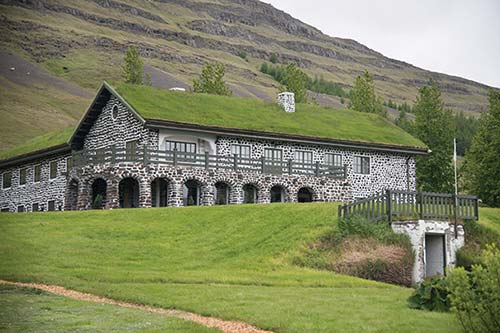
To reach the little settlement of Skriðuklaustur (“Landslide Monastery”), turn left after the bridge (onto highway 933) and drive five minutes. The sights here are a bit underwhelming: Gunnarshús, the home of author Gunnar Gunnarsson (1881-1975), who made a name for himself in Denmark and Germany writing popular books about Iceland (www.skriduklastur.is); the Snæfellsstofa visitors center, run by the nearby national park, with advice on hiking and other activities (look for boxy building on the left at the Skriðuklaustur turnoff, tel. 470-0840, www.vjp.is); and the scant remains of the Skriðuklaustur monastery, the final Catholic monastery built in Iceland before the Reformation (c. 1493). It’s been excavated in recent years (look for information panels at the site)...but there’s not much to see.
For lunch consider the top-notch $$$ Klausturkaffi, downstairs in the Gunnarshús. This wonderful little spot is run by a mother-and-daughter team, who lay out a buffet of traditional, homemade Icelandic dishes. It’s a filling, delicious, and memorable meal (April-mid-Oct daily 12:00-14:30, they also have a coffee-and-cake buffet daily 15:00-17:00, tel. 471-2992).
South from Skriðuklaustur: With even more time, you could continue south of town and up the valley, where there are some natural thermal pools, a museum about Iceland’s Highlands, an abandoned farm with a crank-it-yourself cableway bridge, a closer look at Snæfell (Iceland’s tallest mountain not covered by a glacier), and plenty of hiking options. For details, ask at the Snæfellsstofa visitors center or stop in at the Wilderness Center, a 20-minute (10-mile) drive, on partly unpaved roads, past Skriðuklaustur (tel. 440-8822, www.wilderness.is).
If you stay an extra night in Egilsstaðir and are interested in environmental issues or dams, you could take a day to drive south to the big dam at Kárahnjúkar, in Iceland’s reindeer country (though the animals don’t always show themselves). The tiny coastal village of Bakkagerði (also called Borgarfjörður Eystri), a good hour to the northeast by car, is another interesting destination for those not in a rush.
Sleep here only if Seyðisfjörður is full, you’re in a rush, or the roads are questionable; Egilsstaðir spares you the challenging drive over Fjarðarheiði pass. $$$ Gistihúsið Egilsstaðir, on the site of the original Egilsstaðir farm, is a big, functional, group-oriented, country-style hotel renting 52 rooms (near the lakefront just off the town’s main intersection, tel. 471-1114, www.egilsstadir.com, egilsstadir@isholf.is). Up above town—just before you head up the road to Seyðisfjörður—is $$$ Hótel Eyvindará, with 35 rooms and seven cottages in a rustic, forested setting (tel. 471-1200, www.eyvindara.is, eyvindara2@simnet.is).
Eating in Egilsstaðir: For an easy roadside meal, $ Bókakaffi—in Fellabær, right along highway 1, is a cozy, old-timey bookshop/café that serves an inviting weekday lunch of soups and savory crêpes. In the late afternoon, they have a coffee-and-cake buffet (Mon-Fri 11:00-18:00, closed Sat-Sun, watch for it on the right immediately before crossing the bridge into Egilsstaðir, www.bokakaffi.is). The recommended Gistihúsið Egilsstaðir hotel also has a pricey but good restaurant, $$$ Eldhúsið, that’s open to nonguests. You’ll find a Bónus supermarket on highway 1, near the town’s main junction (open daily).
The most appealing town in eastern Iceland, Seyðisfjörður (SAY-this-FYUR-thur, pop. 700) is a strange hybrid. It’s a gritty, workaday port, where the Norröna car ferry from Denmark injects Iceland with a weekly fix of international car-trippers. But it’s also, per capita, Iceland’s most artistic corner, with a youthful, creative spirit. Fortunately, these two factions wear their peeling paint and rust equally well. Postindustrial decay just looks right in Seyðisfjörður.
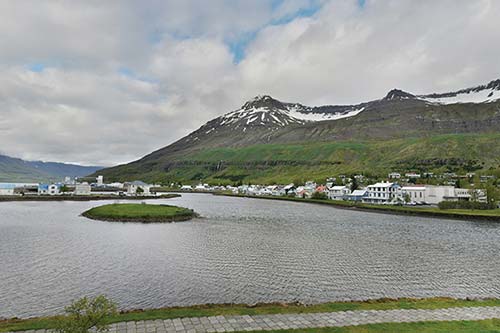
The town—with a fine harbor at the innermost point of a 10-mile-long fjord—was built up by Danish merchants in the mid-19th century; it boomed around the turn of the 20th century thanks to Norwegian-run herring fisheries. Many fine buildings survive from this time, when Seyðisfjörður also became the terminus for the telegraph cable connecting Iceland to Europe. As herring stocks collapsed, the town went into slow decline.
Fortunately, the town took an artistic turn—largely thanks to German artist Dieter Roth (1930-1998), who moved to Iceland in 1957 and later founded an art academy here. Today Seyðisfjörður’s art programs attract young people from across Iceland and abroad, giving this tiny, remote community an unexpectedly cosmopolitan vibe. A top-notch sushi restaurant and a bustling microbrew pub face each other across the rainbow-painted main drag.
While light on “sights,” per se, Seyðisfjörður is an enjoyable place to simply wander and explore. The town has more than its share of services for travelers, thanks to the regular ferry traffic.
Tourist Information: The TI is inside the ferry terminal, but save yourself a trip by checking their excellent website (tel. 472-1551, www.visitseydisfjordur.com).
Get your bearings in this little burg with this brief spin-tour and stroll. Begin just across the bridge from the supermarket and Hótel Aldan, by the black obelisk honoring Otto Andreas Wathne—a Norwegian entrepreneur who helped develop the town.
Spin Tour: Look out over the little lagoon (Lónið), and find the white tower and glass gangway for the Norröna car ferry, which runs weekly to the Faroe Islands and Denmark. The ferry, the town’s main industry, is an important plot point for the popular Icelandic TV series Ófærð (Trapped), which is set in Seyðisfjörður.
Look farther right and up the road, which runs along the fjord past the Hótel Snæfell and below a pretty waterfall. For some remote seaside beauty, you can walk (or drive) as far as you like along this road, which extends 10 miles to the end of the fjord.
Next, spin right to look up into the little town center. The gray-and-red blocky building is the town’s fine thermal swimming pool. Standing out front is an abstract sculpture, called Útlínur, that represents the outline of the fjord. This sculpture, and the murals adorning the school building at the corner, are reminders of the importance of art in this remote hamlet. Uphill and just to the right of the swimming pool, the classic old red building, once the town hospital, is now its youth hostel. Notice the little rust-colored half-pillar across the street from you (by the river), which identifies area peaks.
Stroll: Now let’s stretch our legs. Cross the bridge, turn right at Hótel Aldan, and walk up the pretty “rainbow street” toward the town church. This colorful stretch captures Seyðisfjörður’s creative spirit. On the left you’ll pass the local pub, which is the place in town to sample Icelandic microbrews. The next house, slathered in black-and-white graffiti, is a local art boutique called Gullabúið. At the end of the street is the photogenic, but often closed, Blue Church (Bláa Kirkjan), which hosts weekly concerts in summer (www.blaakirkjan.is). A block behind the church is Snjóflóð (Avalanche), a monument made with the mangled girders of a factory that was swept away by an avalanche in 1996. Scenic as they are, the steep mountain walls around Seyðisfjörður come with a steep price: the danger of being buried by snow.
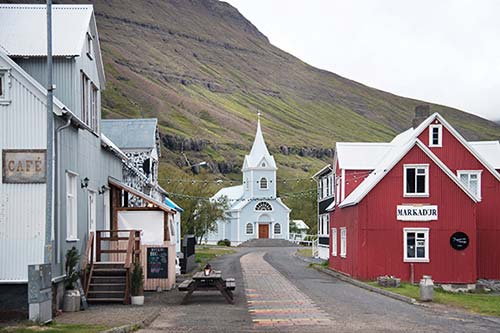
From here, if the weather’s decent, it’s an enjoyable 15-minute stroll around the lagoon—offering enjoyable looks at local homes and backyards.
If you’re lingering here, you can explore a variety of artistic sights. For example, a 15-minute hike up a steep hillside (above the Brimberg seafood factory) is Tvísöngur, a “sound sculpture” made of interconnected concrete huts that resonate in a five-tone harmony. The Skaftfell Center for Visual Art often has free exhibitions on view. They also guide tours through the House of Geiri, the former home of a local artist (summer only, www.skaftfell.is/the-house-of-geiri).
The town is also home to the Technical Museum of East Iceland, housed in a machine shop, where you can learn about everything from town history to that original telegraph (www.seydisfjordur.org).
Avid hikers can attempt to climb the Bjólfur mountain, with stunning views over the fjord (1,970 feet; you can hike steeply up from the avalanche barriers on the Fjarðarheiði road), or the Seven Peaks that surround the fjord.
Remember, Seyðisfjörður can fill up on the night before the weekly ferry leaves—book well ahead on those days. Hótel Aldan is the only of these listings to serve breakfast (a buffet for which they charge a hefty fee). It’s open to nonguests and is where virtually every tourist in town winds up each morning. You can also buy breakfast items at the supermarket.
Hótel Aldan offers the town’s only real hotel rooms, divided between two historic buildings. Check in at their reception building in the heart of town (can’t miss it, by the bridge), and they’ll take you to one of two annexes: $$ Hótel Snæfell, a creaky old house on the waterfront with 12 contemporary-style rooms; or $$$ The Old Bank, with 9 bigger rooms and more amenities, in a residential area (breakfast extra, served at the reception building at Norðurgata 2, tel. 472-1277, www.hotelaldan.is, booking@hotelaldan.com).
$$ Við Lónið (“By the Lagoon”), well run by Maggý, has eight beautifully appointed, modern-minimalist rooms (all with private bath, half with view balconies for extra). It’s right along the main street facing the lagoon and fjord (fjord-facing rooms are quieter and have a balcony for a bit more, mobile 899-9429, www.vidlonidguesthouse.com, email through website to reserve).
$ The Old Apothecary rents three rooms with private bath in a c. 1885 house right at the main bridge in the town center. There’s no reception—you’ll check yourself in—but it’s a good value, and owner Oliver is available if needed (no telephone, website, or email—book on Airbnb or Booking.com).
¢ Hafaldan Hostel, part of the Hostelling International network, runs a tight ship at its two branches: They have 34 beds in the wonderfully creaky old hospital building, and 18 more across the fjord near the old harbor. They also rent private rooms (reception at old hospital location at Suðurgata 8, tel. 611-4410, www.hafaldan.is, seydisfjordur@hostels.is).
Hótel Aldan has two pricey but excellent eateries in its reception building (at Norðurgata 2) in the heart of town: $$$ Nordic Restaurant, on the main floor, has a nicely rustic, casual atmosphere and modern Icelandic fare, including good salads (May-Sept daily 12:00-22:00, tel. 472-1277). Upstairs, $$$$ Norð Austur (“North East”) has exceptional sushi and other Japanese-Icelandic fusion dishes in a cozy setting. The ingredients are fresh, the chefs are talented, and the ambience is delightful. Let this place tempt you into a splurge (dinner only, June-Sept daily 17:00-22:00, tel. 787-4000, www.nordaustur.is).
$$ Bistro Skaftfell is a casual cellar bar below an art gallery, a short walk around the fjord from downtown. They have affordable pizzas at lunch or dinner, as well as a small, changing menu of main courses at dinner, always with a vegan option. Order at the counter, then find a seat; feel free to head upstairs to see what’s on in the gallery (daily 12:00-21:00, Austurvegur 42, tel. 472-1633).
$ Kaffi Lára (named for the house’s former resident)—also called “El Grillo” for the local beer on tap—is a boisterous bar right along the little main street, serving 20 types of beer and basic pub grub. On weekends, it’s open very late and rollicking, with occasional live music (daily 12:00-22:00, Norðurgata 3, www.elgrillobrew.com).
Supermarket: Stock up on picnic or breakfast supplies at Samkaup Strax (marked Kjörbúðin), right at the bridge in the center of town (open daily).
Driving along the Eastfjords (from Seyðisfjörður) to Southeast Iceland is a long but scenic day. Following my recommended route, it’s about 145 miles (3.5 hours nonstop) to the lighthouse at Hvalnes point (which marks the shift to the southeast landscape) and 175 miles/4 hours to Höfn (the biggest town in the southeast region).
As you plan your day, note that you may want to continue beyond Höfn before stopping for the night. It’s another 45 minutes to accommodations near the glacier lagoon at Jökulsárlón, and 45 minutes beyond Jökulsárlón to Skaftafell National Park. The farther you get tonight, the shorter tomorrow’s drive will be.
Before leaving Egilsstaðir, it’s smart to stock up on supplies, use the WCs, and get gas. Services are extremely sparse for the rest of the day. From Egilsstaðir, you have two options for continuing south:
Option 1, Highway 95 (summer only): This inland route is shorter but less scenic than option 2 (my recommended route). It climbs up to 1,500 feet over an unpaved pass, descending to the coast near Breiðdalsvík. You could then take the shortcut along highway 939, called Öxi—a sometimes-steep gravel road with no guardrails that climbs even higher, to 1,800 feet. Taking Öxi shaves about 30 miles off the trip, but only a little time, as you’ll need to drive slowly. (If you’re weighing the choice, check out videos of driving Öxi on YouTube, and look at current road conditions at www.road.is.)
Option 2, Highway 1: The main route hugs the coast and is more scenic, paved all the way, adds about 30-45 minutes to your drive, and is the route I recommend (and detail next). From Egilsstaðir, highway 1 runs down to the sea at Reyðarfjörður; from there, the highway continues through a tunnel and along the coast.
• From Egilsstaðir’s main intersection (at the N1 gas station), take highway 1 (marked Reyðarfjörður) southeast. (Coming from Seyðisfjörður, you can bypass Egilsstaðir as you drop down from the pass.) You’ll curve down a long, grooved valley, framed by craggy mountains rutted with waterfalls. Finally you hit your first fjord at...
Reyðarfjörður (“Baleen-Whale Fjord”): The fjord is home to an industrial town of the same name (pop. 1,100). When you’re still a mile or so outside of town, watch on the right for the turnoff to stay on highway 1 (marked Fáskrúðsfjörður and Höfn). You’ll cut across a few thin rivers, and enjoy views across the fjord on your left of the town of Reyðarfjörður. The aluminum smelter located here gives Reyðarfjörður a more diverse economic base than usual in a small Icelandic village, and more jobs—a key to keeping young people here.
• From Reyðarfjörður, you’ll go through a nearly four-mile tunnel, then drive down toward—but not through—the village of Fáskrúðsfjörður.
Long ago, Fáskrúðsfjörður (“Austere Fjord,” pop. 660) was a supply center for French boats fishing off Iceland, and honors its history with both Icelandic and French on its street signs.
• At the fork as you approach town, turn right to stay on highway 1 (marked Stöðvarfjörður).
Now settle in for a lo-o-o-ong drive—a couple of hours, at least, cutting in and out of deep fjords and passing scattered farms. Highway 1 goes up and down and up and down, as you cross the various finger foothills of the mountains, then drops down into deep ravines formed by receding glaciers. Each fjord is anchored by a sparsely populated little village. These hardscrabble communities debate whether to keep schools open and services alive. Pull over as you like for photo ops—there are ample roadside waterfall views. If it’s sunny, you’ll be in heaven. If it’s socked in...pretend.
First, dramatic Stöðvarfjörður (pop. 200) has a handy little Saxa guesthouse/café/gas station. The town also has a little museum (Steinasafn Petru) that displays the rock collection and garden of a dearly departed local woman (www.steinapetra.is).
Next, Breiðdalsvík (“Wide-Valley Bay,” pop. 140) is wider and less scenic—notice it’s a vík (bay) rather than a fjörður (fjord). The cozy, artsy $ Kaupfjélagið café/general store is a good pit stop here. This town is better developed for tourism than some, and even has some accommodations and a spiffy website (www.breiddalsvik.is). (Note that at Breiðdalsvík, highway 95 rejoins highway 1.)
Berufjörður, a long, skinny fjord, has virtually no settlement at all. Just as you’ve rounded the bend from Breiðdalsvík, watch on your right for the blink-and-you’ll-miss-it organic farm $ Havarí. Tucked in the back of the barn is a little café run by a local artist/musician couple. They serve a vegetarian menu and host live music events every other week though the summer (daily, shorter hours off-season, they also rent a few hostel beds, www.havari.is). A bit farther along on the left (just after Þiljuvellir farm), watch for Blábjörg—naturally “blue cliffs” that rise above a black-pebble beach.
At the far end of Berufjörður, you’ll pass the towering, pyramid-shaped Búlandstindur mountain, then reach Djúpivogur (DYOOP-ih-VOE-ur, “Deep Cove,” pop. 500)—considered the last town of the Eastfjords. With its harbor huddling under beautiful views of grand peaks, Djúpivogur is a natural place to take a break. $ Við Voginn is a diner-style eatery perched on a little hill with views over the harbor (burgers, fish-and-chips, tel. 478-8860). Nearby, $ Langabúð is a historic log building from 1790, housing a museum and a café. If you’re desperate to recharge, there’s a fine little municipal swimming pool at the top of town.
• From Djúpivogur, you’ll leave the fjords in your rearview mirror. It’s another 45 minutes to Hvalnes point.
With the fjords behind you, you’ll curl around two more bays—Hamarsfjörður (”Crag Fjord”), then Álftafjörður (“Swan Fjord,” speckled with islands)—with stunning views of cascading mountains receding to the horizon.
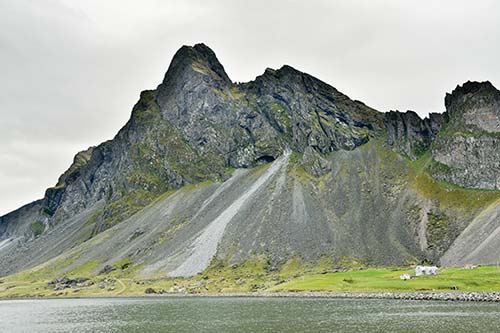
Near the end of Álftafjörður, you’ll pass the little point called Þvottá where, in the tenth century, a missionary sent by the king of Norway first arrived to Christianize the Icelanders. This “Washing River” (as its name means) is where the missionary baptized his first Icelander.
Just after, you’ll round the bend of the last of the Eastfjords, pass the Stapinn sea stack, then reach the point of land marked by the Hvalnes lighthouse. Here the landscape changes unmistakably. You’re no longer in fjord country, but in Southeast Iceland.
To continue your drive to Höfn—the biggest population center for about 300 miles (about 30 minutes away)—and through the rest of the southeast, see the next section.
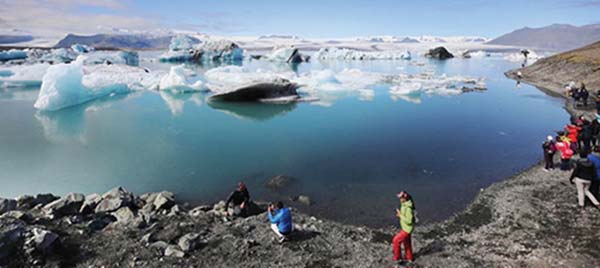
The rugged, 200-mile-long coastline of Southeast Iceland is shaped by Vatnajökull, Iceland’s (and Europe’s) biggest glacier. It is massive: By volume, Vatnajökull (VAHT-nah-YUR-kutl, “Lakes Glacier”) contains more water than Africa’s Lake Victoria, and by area, it’s larger than the state of Delaware. Greedy with its superlatives, Vatnajökull is also home to Iceland’s tallest mountain (Hvannadalshnúkur, 6,900 feet). This is one big chunk of ice.
Throughout Southeast Iceland, the Ring Road tightropes between Vatnajökull and the open Atlantic. You’ll cross many broad beaches of pebbles, ground up and washed out by glaciers, and get a good look at several glacier tongues, stretching down from the top of the big ice monster and lapping at the lowland valleys.
Southeast Iceland has a few widely scattered sights, including some spectacular natural wonders. The highlights are glacier lagoons, where icebergs bob in dreamy pools: the famous (and quite touristy) Jökulsárlón, and the lesser-known and smaller Fjallsárlón. Near Jökulsárlón is the so-called Diamond Beach, where glittering chunks of ice wash up on a velvety black sand beach.
To get up close to all that glacial scenery, the Skaftafell wilderness area offers hikes, from easy to strenuous. And the main town of this area, Höfn, is a practical, peninsular little burg whose restaurants specialize in the delectable local specialty, humar (langoustine).
Planning Tips: You’ll likely want to spend a night in this area, to rest up between two long days of driving. Accommodations are sparse, so book well ahead. While Höfn is the only real town in Southeast Iceland—and has some good accommodations—it’s at the region’s easternmost end, so sleeping there makes the next day’s onward drive that much longer. From a practical point of view, you may be better off dining in Höfn, then continuing farther west to your hotel. You’ll find accommodations around Hali and Jökulsárlón, 45 minutes past Höfn (allowing you both a late-evening and early-morning look at the glacier lagoon), and in the Skaftafell area, another 45 minutes beyond that.
Glacier Activities: It’s best to reserve ahead for many activities in this area, including boat trips on the glacier lagoons; hiking or snowmobiling across a glacier; or visiting an ice cave. For details on your options, see the Icelandic Experiences chapter. Do some homework and book your activity a few days ahead (as soon as weather reports become reliable), but before they sell out (most attractions have online calendars that count down available slots). Consider booking your activity for the morning after you overnight in the southeast (avoiding a stressful drive to make a late-afternoon appointment). If you’re especially interested in glacier activities, add a second overnight—either in this area, or along the South Coast.
Driving from where Southeast Iceland begins (at Hvalnes point) to Vík (which kicks off the South Coast) is about 200 miles—or about four hours of driving, nonstop. Some of Iceland’s most impressive natural sights are here, but they’re spread out, with long stretches of road in between. In this section I describe the drive between Hvalnes point and Vík. For detailed descriptions of the towns and sights recommended along this route, see the “Southeast Iceland Towns and Sights” section later in this chapter.
Sandstorm Alert: The most dangerous area for potentially car-damaging sandstorms along the Ring Road is the section between Skaftafell and Vík, where you’ll pass through wide stretches of sand. If windy conditions are forecast, try to avoid this area.
Hvalnes Lighthouse: The first stretch—as you round the bend from the Eastfjords, at Hvalnes point—offers a glorious introduction to the glacial scenery of the southeast. The simple orange tower of Hvalnes lighthouse, barely visible from the road, welcomes visitors to this area. Notice the more intense surf here—crashing on the rocks—rather than the gentle lapping of Eastfjord waves.
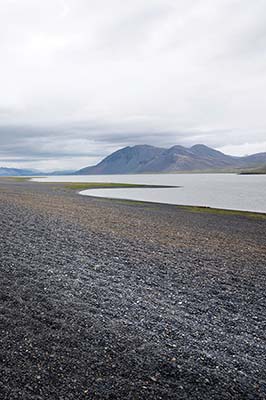
Lónsvík Bay: Immediately after the lighthouse, there’s a pullout at the end of an astonishingly long, far-as-the-eye-can-see, natural causeway along the bay of Lónsvík. Scrambling out on the pebbly footing provides a nice stretch-your-legs-after-the-fjords, welcome-to-the-southeast moment.

Continuing around the bay, notice that the landscape has shifted from mossy cliffs to massive, sloping mounds of loose pebbles. Keep an eye out for bunkers on the right side of the road, which block rockslides. And notice the water changing colors, as mineral-murky glacial runoff mixes in shades of green, blue, and yellow.
Just past the settlement of Stafafell, you’ll use a one-lane bridge to cross the first of many glacial riverbeds. These distinctive waterways—where centuries-old ice finally melts and runs off to the ocean—are always shifting.
• At the far end of Lónsvík bay, you’ll go through a short tunnel. Popping out the other side, straight ahead you’ll get your first glimpse of a glacier: the Hoffellsjökull tongue of Vatnajökull. Soon after—about 30 minutes later—you reach the turnoff (on the left, highway 99) for the town of Höfn.
From Höfn to Hali: As it’s the biggest population center for more than a hundred miles in either direction, Höfn is good for a break—gas up, use the WC, and have a meal. For suggestions on places to eat in Höfn, see here. Otherwise, there are a couple of options past town.
Beyond Höfn, the roadside restaurant Brunnhóll has a popular ice-cream counter. But for a better meal, carry on about a mile farther to the recommended $$ Jón Ríki brewery/restaurant (on the right, at Hólmur farm).
About 35 miles (45 minutes) past the Höfn turnoff, on the left, is a building shaped like a long bookshelf, at the little settlement of Hali, with a hotel, no-frills café, and museum honoring a local author.
• About 10 minutes beyond Hali, glacial views open up on your right.
Glacier Lagoons and Tongues: Watch for the big parking lot (on the right, immediately before a white suspension bridge) for the stunning Jökulsárlón glacier lagoon—a must-stop to gape at the icebergs. Getting back on highway 1, cross the bridge and immediately turn left on the unmarked gravel road to reach the just-as-dramatic (and often overlooked) Diamond Beach, where small icebergs wash up on a black sand shoreline.
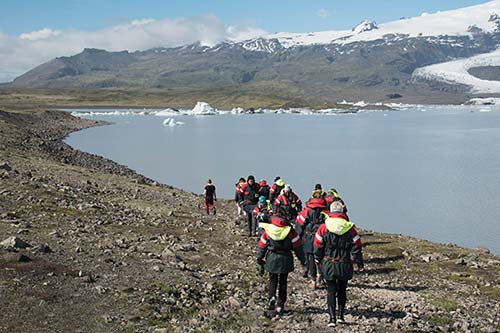
About 10 minutes farther, and easy to miss (since it’s not visible from the road), is another glacier lagoon, Fjallsárlón. This quieter and smaller lagoon has a better view of the glacier itself.
• Back on highway 1, cut across the flats between glacier-topped mountains and coastline.
Take turns spotting the glacial tongues filling grooves in the mountains on your right. About 20 minutes past the lagoons, on the right (just past Hótel Skaftafell), you’ll enjoy ideal views of glacial tongues flowing around a jagged rock face.
In this area, you’ll pass vast purple fields of Nootka lupine. In 1945, this flowering plant was introduced (from North America) to Iceland to combat erosion and to fertilize the soil. It’s now becoming invasive in some areas, and threatens delicate native species—particularly certain mosses. Just down the road, locals are actively destroying fields of lupine to protect what lies beneath.
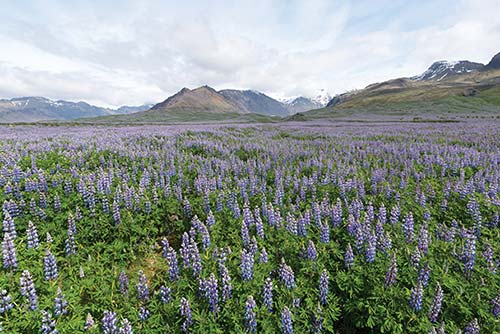
• About 30 miles (45 minutes) past the glacier lagoons, on the right, is the easy-to-miss turnoff for highway 998 and...
Skaftafell National Park: About 1.5 miles off the main road, you’ll reach the park’s visitors center (with WCs and a cafeteria; for more on the park, see later in this chapter).
Almost immediately after the Skaftafell turnoff, on the left, watch for a pullout next to a pair of mangled girders. They’re all that’s left of a bridge that washed out in the fall of 1996: A volcanic eruption heated up a mountaintop lagoon of glacier water, which came rushing down the mountainside in a days-long flood that peaked at more than 10 million gallons per second. Such floods, called a jökulhlaup, are relatively common along Iceland’s southern coast. That’s partly why many of the bridges you’ll cross on this drive are wimpy one-lane ones, which can be easily replaced.
• Continuing west, you’ll cross the extremely broad outwash plain called...
Skeiðarársandur (“Spoon-River Sands”): The majority of meltwater from Vatnajökull drains to the Atlantic from this delta, which covers 500 square miles—the largest such glacial drainage delta in the world. (Geologists worldwide sometimes call an outwash plain a sandur—borrowing the Icelandic word). To cross Skeiðarársandur, you’ll go over an extremely long one-lane bridge (take turns with oncoming traffic on the strategically placed pullouts).
Approaching the end of the sands, you’ll spot the beefy peak called Lómagnúpur. Here the landscape shifts to jagged lava chunks—striking, sharp-edge cliffs with lots of waterfalls.
• Eventually, about 45 miles (nearly an hour) past the Skaftafell turnoff, you’ll pull into...
Kirkjubæjarklaustur: The lone point of civilization between Höfn and Vík, Kirkjubæjarklaustur (KEERK-yoo-bay-yahr-KLOY-stur; “Church-Farm Monastery,” pop. 120) is the place to gas up and grab some food. Turn off at the main roundabout and follow the main street; you’ll reach a little building housing the busy $$ Systrakaffi café, a little grocery store, and a liquor store.
• A few minutes past Kirkjubæjarklaustur, there’s a fine little natural area good for stretching your legs. To reach it, just after leaving town, watch for the turnoff marked Holt/206.
Fjaðrárgljúfur (“Feather-River Canyon”): An unpaved road takes you in about 10 minutes to this gently scenic gorge of soft, rounded hills grooved by a deep river (parking lot with WCs and picnic tables). From here you can hike up along the upper rim of the 1.5-mile-long, 300-foot-deep canyon, peering down into its unique formations.
• From Kirkjubæjarklaustur, it’s about an hour (45 miles) to the next town, Vík.
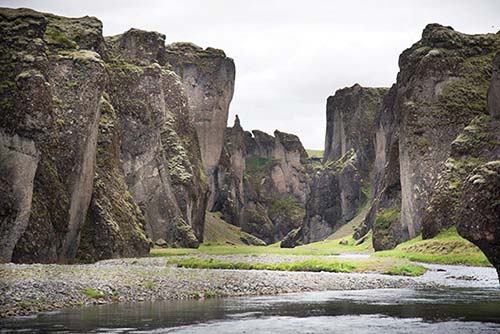
The Road to Vík: You’ll pass through an otherworldly volcanic landscape of lava rock blanketed with yellow moss—a world of molehills with pointy tops, alternating with purple lupine. Somewhere in there, you’ll see a pointy-ridged mountain that looks like a sleeping stegosaurus. And soon you’ll begin to catch glimpses of the Mýrdalsjökull glacier on the horizon to your right.
Before long, you’re crossing another broad sandur (Mýrdalssandur). The row of cliffs on the left marks your next stop: the town of Vík, the gateway to the South Coast area.
You’ll reach the following towns and sights as you drive south from Hvalnes to Vík via the route above.
Höfn (“hurpp,” with a nearly silent n; pop. 2,200) is the only real town in Southeast Iceland. This fishing-harbor town doesn’t have much to see, but it offers easy access to the Vatnajökull glacier, a supermarket, a good swimming pool, and some enticing places to eat. The harborfront, more practical than quaint, serves as a local tourism hub, with lots of restaurants and tour operators offering trips to the glacier. In this area is a handy national-park visitors center called Gamlabúð.
Eating in Höfn: Höfn is a good, if expensive, place for a meal, with several seafood restaurants clustered around the harbor. Most menus are dominated by the local delicacy, humar (langoustine—a smaller cousin of the American lobster). While you’ll pay royally to sample it, foodies consider it a justifiable investment. $$$$ Pakkhús Restaurant has a lively dining room, a cozy pub downstairs, and a menu of humar and other specialties. If you really want to settle in for a memorable meal at the end of a long day’s drive, do it here (daily 12:00-22:00, Krosseyjarvegi 3, tel. 478-2280, www.pakkhus.is). For something simpler and cheaper, try the diner-style $ Hafnarbuðin, which sits in a little shack farther around the harbor. Order at the counter, then try to find a seat in the cramped interior. Their “langoustine baguette” is Iceland’s answer to a lobster roll (they also serve fish-and-chips and other basic meals, daily 9:00-22:00, Ránarslóð 12, tel. 478-1095). $$ Íshúsið is a good, high-end pizzeria right on the harbor (daily 12:00-22:30, Heppuvegur 2a, tel. 478-1230, www.ishusidpizzeria.is). Farther out, along the road toward highway 1, $$$ Kaffi Hornið is a convivial, reliable choice for comfort food in a log-cabin shed (daily 11:30-23:00, Hafnarbraut 42, www.kaffihornid.is).
Eating near Höfn: $$ Jón Ríki (“Jón the Rich”) is tucked in a nondescript farming settlement called Hólmur, right along the Ring Road (about 20 minutes/17 miles west of the Höfn turnoff). This sociable, casual microbrewery/restaurant, in an artistically decorated barn, serves pizzas and local dishes. Reserve ahead in peak season (daily June-Aug 11:30-14:00 & 18:00-21:30, closed off-season, tel. 478-2063, www.jonriki.is).
Sleeping in and near Höfn: See the “Sleeping in Southeast Iceland” section, later in this chapter.
The 20th-century Icelandic author Þórbergur Þórðarson was born on this farm in 1888. Þórbergur is most remembered for his humorous, self-deprecating essays and The Stones Speak, a memoir of his childhood in this isolated place, where the glacial rivers weren’t bridged until the 1970s.
The farm is now home to the Þórbergssetur museum, which is designed to look like a giant bookshelf containing Þórbergur’s works. Inside, you’ll learn about the history of the property and its famous resident, and you can step into a re-created baðstofa (main room of a traditional farmhouse) and bedroom. The exhibit makes Þórbergur and his writings meaningful to outsiders—and it’s a good break from driving. (The building is also the reception for the recommended Hali Country Hótel—see “Sleeping in Southeast Iceland,” later.)
Cost and Hours: 1,000 ISK, if they’re not busy an attendant can show you around, daily 7:30-21:00, café, tel. 478-1078, www.thorbergur.is.
This glorious sight is one of Iceland’s best: a lagoon where giant, bobbing chunks of centuries-old ice float in dreamy tranquility, in front of a glacier backdrop. The lagoon called Jökulsárlón (YUR-kurls-OUR-lohn, “Glacier-River Lagoon”) first appeared around 1935, gouged out by the receding Breiðamerkurjökull glacial tongue (which continues to retreat about a foot per day, a pace that has increased dramatically over the last decades). The lagoon covers seven square miles and reaches a depth of up to 800 feet; the water temperature hovers just above freezing. Salt water backing up the river into the lagoon helps prevent it from freezing over. (The nearby Atlantic rarely goes above about 45°F.)
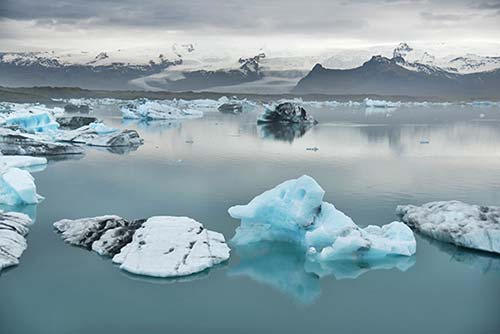
Spot any wildlife? Occasionally seals swim up the river and can be seen basking on the ice chunks. And various seabirds, including Arctic terns, nest nearby in the early summer. If you happen to wander too close to a nest, you could get dive-bombed.
Glacier Lagoon Boat Trips: At Jökulsárlón, you have two options for getting out on the frigid water—a large, slow-moving “amphibian boat” (5,500 ISK for 45 minutes) or a smaller, faster RIB/zodiac boat (9,500 ISK for an hour). You’ll be provided with warm coveralls and lifejackets, but bundle up before heading out. Ideally, check the schedule and book online once you’re fairly confident that the weather will justify the trip (tours run daily July-Aug 9:00-18:00, shorter hours off-season, no trips Nov-April, tel. 478-2222, www.icelagoon.is).
This dramatic sight hides down an unmarked gravel road (see here for directions), but don’t miss it. Glittering icebergs both large and small lay stranded on a fine black-powder beach...like so many diamonds on display. By the time they reach these sands, many of the icebergs have been tumbled by currents and waves, leaving them shiny and smooth. The beach changes constantly: Sometimes the “diamonds” are many, other times they’re sparse. Sometimes they’re transparent, other times white, occasionally blue, and often there’s a mix of colors and sizes. Photographers can occupy themselves for hours.
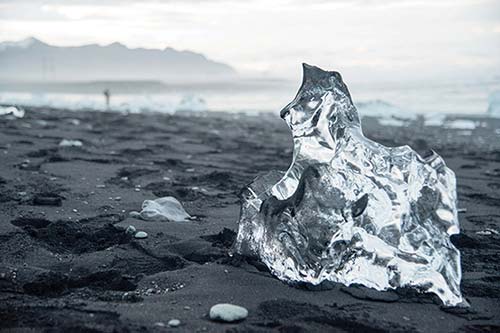
Be extremely careful exploring this area. The Atlantic coastline here is notorious for its sneaker waves, and if you wade into the (frigid) water here, you’re taking your life in your hands. But even from a safe distance, Diamond Beach takes your breath away.
Fjallsárlón (FYATL-sour-lohn, “Mountain-River Lagoon”)—the Back Door alternative to the crowded Jökulsárlón—is just seven miles farther down the main road (10 minutes), but tucked out of sight (watch for easy-to-miss red Fjallsárlón sign). From the parking lot—with a modern services building, including WCs, a good café, and boat-trip ticket offices—you can hike up onto a little ridge for great views of the Fjallsjökull glacial tongue, with the lagoon in the foreground. This lagoon started to form about 20 years ago as the glacier receded up the slope. It’s smaller than Jökulsárlón (about one-fifth the size and one-third the depth), but that means you’re up closer to the glacier itself.
Boat Trips: With Fjallsárlón’s smaller size, the 45-minute RIB cruises here feel more personal and intimate. Boat trips run nearly hourly through the summer (6,800 ISK, April-mid-Oct daily 10:00-17:00, hourly except 12:00, www.fjallsarlon.is). You can just show up and hope for an available slot, but it’s more reliable to book online a day or two ahead.
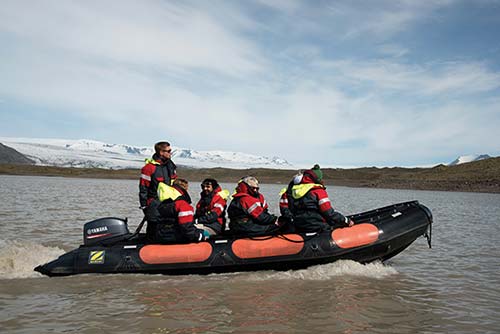
Eating at Fjallsárlón: The modern, inviting $ Fjallsárlón Bistro offers a soup-and-bread buffet and reasonably priced entrées (daily in summer from 11:30 to end of last boat trip).
Skaftafell (SKAFF-tah-fehtl) is part of the Vatnajökull national park (watch for the turnoff for highway 998 from the Ring Road). This area is named for the Skaftafellsjökull glacial tongue, which pokes down from Vatnajökull near the sprawling parking lot (which teems with hikers on nice summer days). The visitors center has some small exhibits about the area and plenty of advice about local hikes (maps for sale, typically open daily 8:00-19:00 in summer, shorter hours off-season, free WCs, tel. 470-8300, www.vjp.is).
Eating at Skaftafell: A big, basic $ cafeteria serves uninspired salads, sandwiches, and main courses (daily 9:00-21:00 in summer, 10:00-19:00 in off-season).
Some people spend days hiking in this area, but even if you’re just passing through, it’s worth sampling one of the trails. Here are some popular choices, all of which begin from the Skaftafell parking lot (time and distance estimates are round-trip). Before heading out, be sure to get the hiking pamphlet (or ideas for other hikes) from the visitors center, and be aware of local weather conditions. The last three hikes require a stiff uphill climb to the ridge called Skaftafellsheiði, which looms above the visitors center.
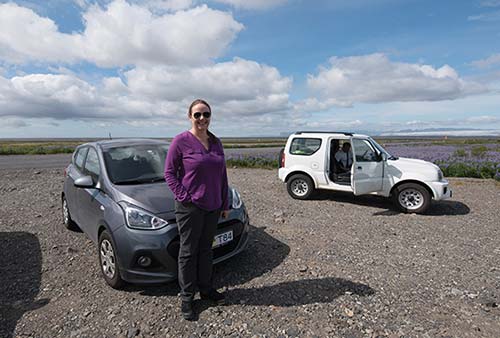
“Geology Trail” to Skaftafellsjökull (easy, 2.3 miles, 1 hour): The easiest and most popular choice, this loop hike (mostly over even and flat terrain, blue trail S1) takes you to the glacier tongue that runs off Vatnajökull. This is perhaps your best chance to get up close to a glacier without taking a lagoon cruise. (If you’re planning to hike at Sólheimajökull farther along the South Coast, this trail may be somewhat redundant.)
To start, you’ll cut through a field, walk along the base of a cliff, and go up the valley cut by the receding glacier. Finally you approach the glacier itself. Conditions may allow you to walk up and touch the glacier (though, more likely, your path will be impeded by a pool of water). Don’t attempt to climb the glacier without proper equipment, and don’t be surprised by the glacier’s brown or black appearance—it picks up a lot of grit as it grinds along its valley.
Svartifoss (moderate, 2-2.5 miles, 1.5-2 hours): While only about 60 feet tall, Svartifoss (“Black Waterfall”) enjoys one of Iceland’s most dramatic waterfall settings, gushing over a cliff of basalt columns. While utterly spectacular, a visit requires a sturdy uphill hike (elevation gain of about 850 feet). Note that there are two routes to Svartifoss: Short and steep (red trail S2), or longer and more gradual (blue trail M3/S2). Sort out your options at the visitors center and take your pick.
Svartifoss-Sjónarsker-Sel (moderate, 3.5 miles, 3 hours): From Svartifoss, further hikes tempt those with more time and energy. One popular, moderate option links the waterfall to the fine viewpoint at Sjónarsker—overlooking the astonishingly broad Skeiðarársandur glacial river delta—and a traditional turf house at Sel (blue trail S2).
Svartifoss-Sjónarnípa (challenging, 4.5 miles, 4-5 hours): More ambitious is the hardy trail across to the hillside to Sjónarnípa, which rewards the effort with stunning views over Skaftafellsjökull. From Svartifoss, you’ll take red trail S5/S6.
For these up-close glacier experiences you’ll need to book ahead with a private company. The following offer one or both activities: Glacier Journey (www.glacierjourney.is), Arctic Adventures (www.adventures.is), and Extreme Iceland (www.extremeiceland.is). For glacier walks, these companies are more specialized: Icelandic Mountain Guides (www.mountainguides.is) and Glacier Guides (www.glacierguides.is). For more on glacier activities, see the Icelandic Experiences chapter.
For locations, see the map on here.
In Höfn: The guesthouse called the $$$ Milk Factory, along the road between Höfn and highway 1 (a long walk or short drive from the harbor), is a fun choice, renting 17 rooms with clean, tidy, modern style (Dalbraut 2, tel. 478-8900, www.milkfactory.is, reception@milkfactory.is). $$$ Hótel Edda Höfn is your big-hotel option in town, with a large, modern lobby and 36 rooms in a characterless building just off the harbor (breakfast extra, Ránarslóð, tel. 444-4850, www.hoteledda.is, edda@hoteledda.is). $$ Guesthouse Dyngja is a reliable, simple, traditional place with seven rooms (some with shared bath) a few steps above the harbor (tel. 866-0702, www.dyngja.com, fanney@dyngja.com).
In the Countryside near Höfn: In a modern motel-style building, $$$ Seljavellir Guesthouse is practical with 20 rooms in a farm valley just off highway 1 a few minutes north of Höfn (tel. 845-5801, www.seljavellir.com, info@seljavellir.is).
Between Höfn and the Glacier Lagoons: Tucked beneath a huge mountain about a half-hour from Höfn or Jökulsárlón, $$ Guesthouse Skálafell is a cozy, family-run compound with nine rooms (some with private bath) and two cottages (tel. 478-1041, www.skalafell.net, info@skalafell.net). $$$ Hali Country Hótel is big and functional, just a 10-minute drive east of the Jökulsárlón glacier lagoon by the Hali farm. It has 39 rooms scattered through three buildings (tel. 867-2900, www.hali.is, hali@hali.is). They also have a restaurant and a museum about the writer Þórbergur Þórðarson, who grew up here (described on here).
Between Skaftafell and Vík: Cozy and well-run, $$$ Hrífunes Guesthouse is almost to the South Coast; some rooms have views, and some have private bathrooms (tel. 863-5540, www.hrifunesguesthouse.is).
Big Chain Hotels: For less personality but plenty of beds, you’ll find big branches of well-established Icelandic chains that cater mainly to tour groups. $$ Icelandair Hótel Klaustur has 57 rooms in the village of Kirkjubæjarklaustur (tel. 487-4900, www.icelandairhotels.com, klaustur@icehotels.is), while the Fosshotel chain has multiple branches (www.fosshotel.is): $$ Fosshótel Núpar, with 60 rooms in Kirkjubæjarklaustur (tel. 517-3060); $$$$ Fosshótel Glacier Lagoon, a newer splurge with 104 rooms between Skaftafell and Jökulsárlón (tel. 514-8300, glacier@fosshotel.is); and $$ Fosshótel Vatnajökull, with 66 rooms just outside of Höfn (tel. 478-2555, vatnajokull@fosshotel.is).
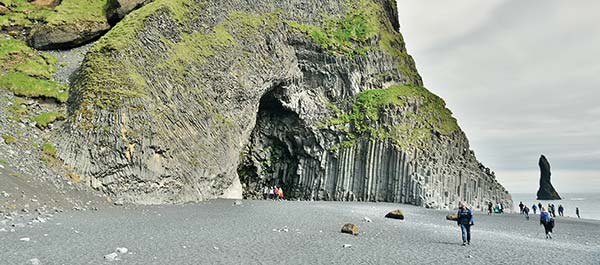
Iceland’s South Coast—stretching from Vík about 40 miles west to the Markárfljót river and Seljalandsfoss waterfall—is one of Iceland’s most enjoyable corners. Within this hour-long stretch you’ll encounter black sand beaches, scenic promontories, hikeable and touchable glaciers, a pleasant folk museum, and two spectacular waterfalls. On the way back to Reykjavík, there’s less to see, though the Lava Centre is a good stop to learn more about volcanoes.
Planning Tips: If you’re rushing the Ring, you’ll have a busy day of sightseeing and a late drive back to Reykjavík. Spending a night here allows you to linger at the area’s attractions before returning to Reykjavík (or side-trip to the Westman Islands, an easy ferry ride from here, if the weather cooperates).
For more specifics on the South Coast—including a map, sightseeing details, recommended eateries and accommodations, and strategic tips—see the South Coast chapter. Since that chapter is designed for day trips from Reykjavík, the sights are presented there in “backwards” order for those completing a clockwise Ring tour. Below is a rough outline for visiting these sights, traveling from east to west.
The first part of the drive—from Vík to Seljalandsfoss waterfall—takes only about an hour (about 40 miles), but contains many hours’ worth of sightseeing. (If you’re very selective, you can have a satisfying visit to this stretch in about 3-4 hours.)
Once you leave Hvolsvöllur (and its Lava Centre), it’s a fairly straightforward 1.5-hour, 70-mile drive to Reykjavík, with fewer temptations en route.
From Vík (where you’ll find gas stations and eateries), you’ll twist up and over a mountain pass. As you descend, watch on the left for the turnoff to the Reynisfjara black sand beach, with striking basalt formations, scenic sea stacks, handy beach café, and dangerous sneaker waves (10-minute drive from the main road on highway 215).
Just a bit farther along on highway 1, the turnoff for highway 218 leads five minutes to Dyrhólaey promontory, with fine views and a lighthouse hike (skippable for those in a rush).
Continuing 25 more minutes, you’ll reach the turnoff for Sólheimajökull glacier (a five-minute drive from the Ring Road on highway 221). From the parking lot, it’s a 15-minute hike to the glacier itself; depending on conditions (and your own surefootedness), you can often walk right up and touch the glacier. But if you’ve already visited the glacier lagoons in the southeast, this is skippable.
Just past the Sólheimajökull turnoff, also on the right, is the settlement called Skógar, which has a striking waterfall (Skógafoss) and a folk museum.
From here, the road continues west in the shadow of Eyjafjallajökull, the volcano whose 2010 eruption famously disrupted European air travel. A small, roadside Iceland Erupts exhibit tells the story (but the Lava Centre—coming up soon—relates it more professionally). You’ll enjoy great views of the Westman Islands, with teeth-like cliffs hovering just offshore (for details, see Westman Islands chapter).
Around 25 minutes (18 miles) after leaving Skógar, turn off on the right to highway 249 and the parking lot for the dramatic Seljalandsfoss waterfall—you can actually walk behind the tumbling torrent.
Back on highway 1, you’ll cross the Markárfljót river and curve inland—going through the humble communities of Hvolsvöllur (with its excellent Lava Centre—a state-of-the-art volcano exhibit), Hella, and Selfoss (with the grave of chess legend Bobby Fischer). Highway 1 cuts north past Hveragerði (with an excellent pizzeria/brewery—see here), then switchbacks up and across the volcanic, desolate Hellisheiði plateau. Before you know it, you’re approaching the Reykjavík suburbs.
Your epic Ring Road odyssey is finally at its end. Well done!